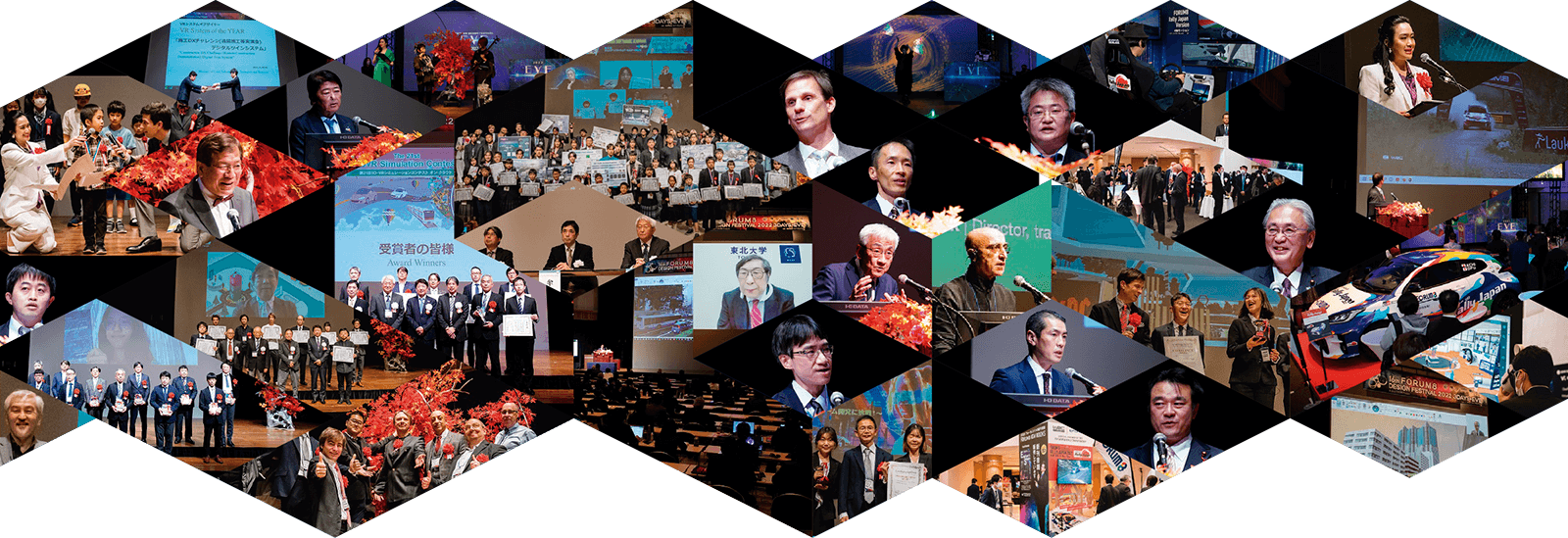EVE 2022.11.15TUE REPORT
-
Real event for the first time in three years under the theme "Reunion"
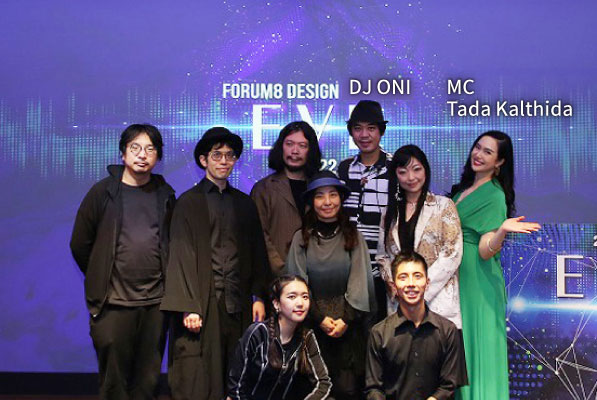
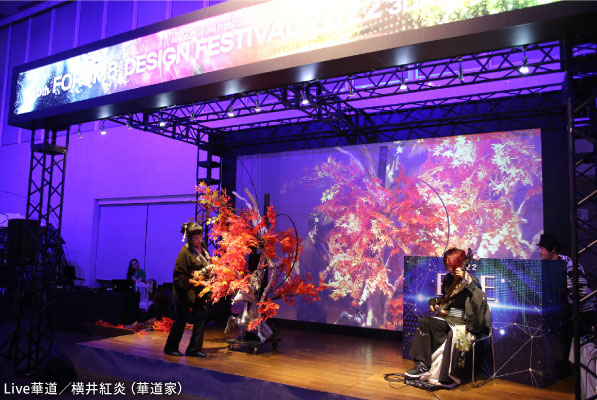
Design Festival 2022 EVE was held under the theme "Reunion" as the first live event in 3 years. Before the event, the review movies of the past online eve events were streamed.
The EVE event started with Kado floral designing live performance by Koen Yokoi, a Sogetsu-ryu style performer. Following it, a unit named Neiro by marimosphere and DJ ONI created crypt art in real time by combining VR art and digital sound, and a danser Miki, a choreographer who joined Tokyo2020, and JUNKO, a classic pianist performed together on the stage.
At the venue, we assembled a new artwork "Bamboo Dome" made of discarded bamboo and cutting-edge expression, which enveloped visitors inside with 3D sound and images in harmony with the sounds of bamboo and nature. The theme of the work was harmony between nature and technology, and between cutting-edge technology and reuse, and it was presented as a work that questioned sustainability.
In addition, for the first time, we held a Crypto Art exhibition and live performance, featuring works incorporating cutting-edge concepts such as AI and NFT, including hasaqui's drawings using AI/p5js works, and marimosphere's abstracted pattern expressions symbolizing AI and blockchain. In addition, Vjyou, Hanahana production, and Edo Rena presented a performance combining video and music.
(Translation up to this part is written by FORUM8)
▲EVE - Reunion - Timelapse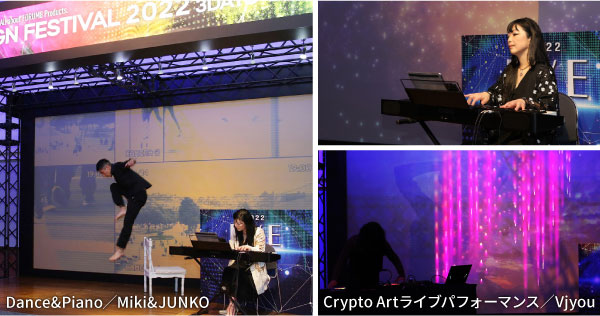
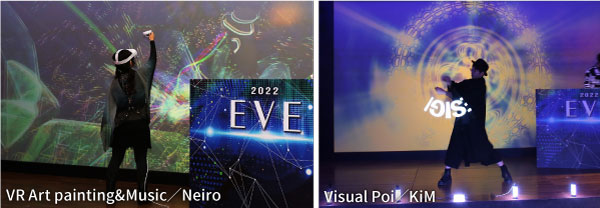

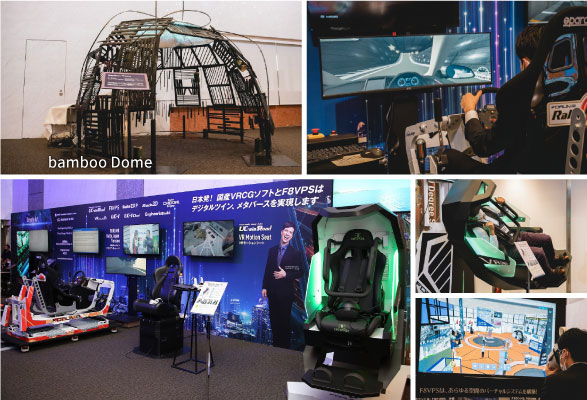
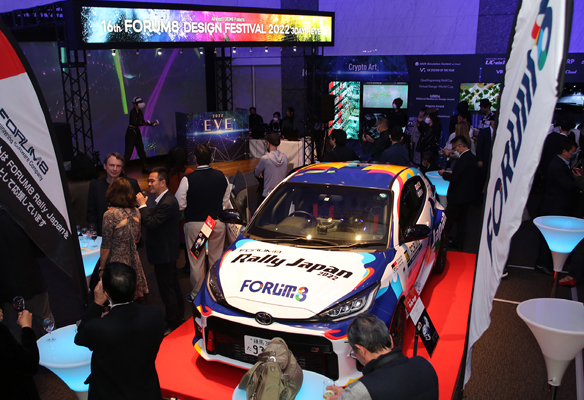
DAY1 2022.11.16WED REPORT
Lecture Material / Movie
Lecture Material / Movie
-
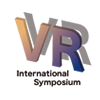 The 7th Autonomous Driving Conference
The 7th Autonomous Driving ConferenceA New Paradigm for Autonomous Driving, Path Drawn by "Future of Digital-powered Transportation Society"

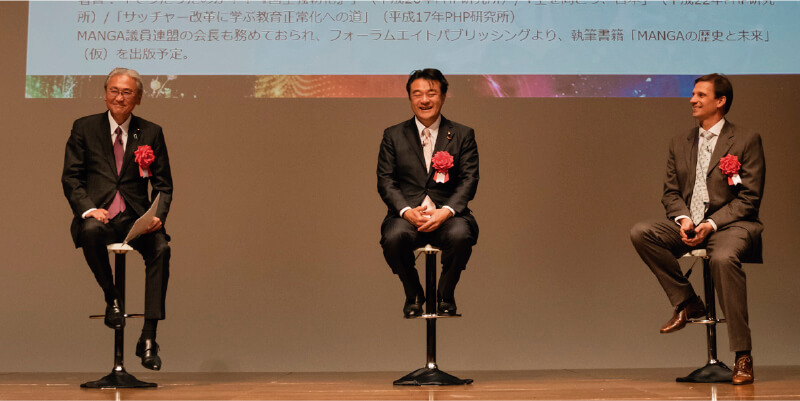
Day 1 of the Design Festival (November 16, 2022) opened the 7th Autonomous Driving Conference, starting with a greeting from Yuji Ito, President and CEO of the Company. As FORUM8 Rally Japan 2022 was held in the same year, guest greetings were given from three speakers including Mr. Keiji Furuya, Member of the House of Representatives (and Chairman of the Parliamentary League for Considering Automotive Culture and so on), Mr. Toshitaka Ooka, Member of the House of Representatives (member of the Parliamentary League for Considering Automotive Culture, and so on), and Mr. Marc de Jong, Director of Business Development, FIA World Rally Championship, WRC Promoter GmbH. Firstly, Mr. Furuya mentioned the significance of FORUM8 serving as a main sponsor of "Rally Japan", 2022 FIA World Rally Championship (WRC) Round 13. Then he presented the effort to work on the Levels 4 and 5 of autonomous driving with his own focus points on it.
Next, Mr. Ooka talked about further efforts for autonomous driving, the usefulness of FORUM8's use of VR technology there, and his expectations for the creation of a new automobile society through them. Finally, Mr. Jong introduced WRC with a video. He said, "Motorsport is also very important for mobility development. Developing engines and batteries in pursuit of vehicle efficiency has led to functional improvement. Besides, for rally cars we use carbon-neutral fuels as well as perform EV driving. It has been proven that technology can overcome various barriers by driving on actual roads in diverse conditions." After mentioning driving and spectator transport by the fully autonomous vehicles for the first time in WRC Rally Estonia (2021), he talked about expectations for FORUM8 Rally Japan to be held next year.
(Translation up to this part is written by Takashi Ikeno)
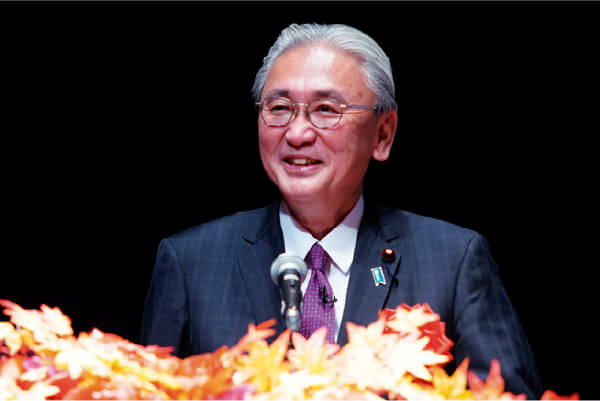
Chairman of the Parliamentary League for Considering Automotive Culture / Member of the House of Representatives Mr. Keiji Furuya
Member of the House of Representatives, the first Minister of State for Disaster Management, National Resilience. After graduating from the Faculty of Economics at Seikei University and working for a major insurance company, he was elected 11 times in the Gifu 5th district of the House of Representatives. Parliamentary League Activities: Executive Acting Chairperson of Policy Research Council, Chairman of the Parliamentary League for the Promotion of Liberal Democratic Party Motorsports, Chairman of the Parliamentary League for Considering Automotive Culture, and many others .. Book: "Is that so !!" National resilience"" (2014 PHP Institute) / "Looking up, Japan" (2010 PHP Institute) / "To normalize education learned from Thatcher reform" Road" (2005 PHP Institute). Also he is a chairman of Parliamentary Association for MANGA and will publish "History and Future of MANGA" from FORUM8 Publishing.
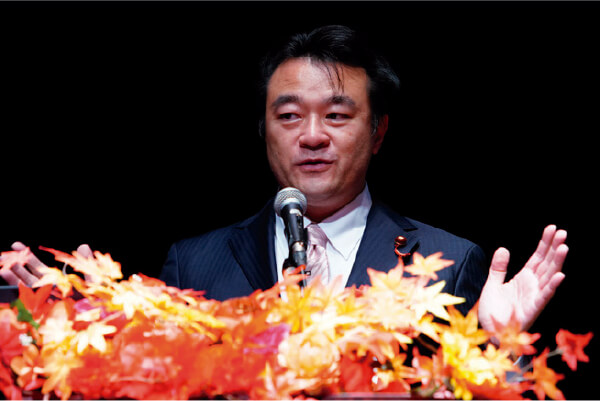
Parliamentary League for Considering Automotive Culture / Member of the House of Representatives Mr. Toshitaka Ooka
Born in Shiga Prefecture. After graduating from School of Political Science and Economics, Waseda University, he worked as a sales staff in Japan and abroad. He was chosen in an election of Hamamatsu City Council for the first time in 1999. In 2007, he won an election for a member of Shizuoka Prefectural Assembly and took the position for the 2 terms. He was elected for a member of House of Representatives from the 1st election area in Shiga in 2012. He became the Parliamentary Vice-Minister of Finance in 2015 and the Senior Vice Minister of the Ministry of the Environment in 2021. A member of Parliamentary League for the Promotion of Liberal Democratic Party Motorsports and Parliamentary League for Considering Automotive Culture.
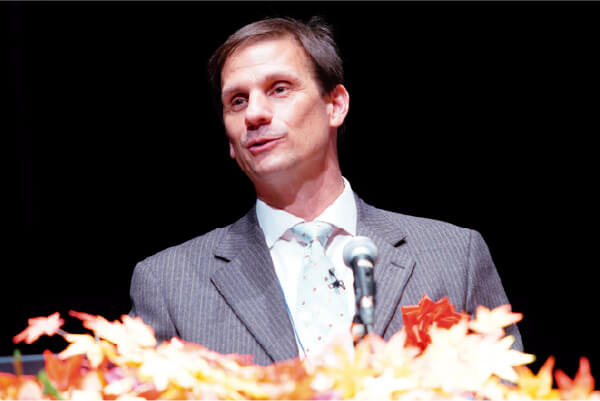
Director of Business Development, FIA World Rally Championship, WRC Promoter GmbH Mr. Marc de Jong
Marc de Jong has been part of the commercial team behind the FIA World Rally Championship (WRC) for over 20 seasons. At WRC Promoter GmbH, Marc is responsible for the commercial relationships with the automotive sector (including OEMs and leading suppliers) as well as licensing and business development. Among specific projects managed by Marc are the development of the new rally events in Japan and the USA, and the publishing of the WRC interactive video games.
Marc has extensive international experience in the car industry, motorsports and broadcasting. He has worked at the highest levels in world rally and other motorsports in projects with major brands and automotive suppliers. Between 2004 and 2010, Marc was part of Energy Efficient Motorsport - a UK government-funded think-tank focussed on promoting the use of sustainable technologies in motorsport. Marc speaks English, German, French and Dutch, as well as being conversant in Spanish. He has competed as an international rally co-driver, most recently in the five-day electric vehicle challenge through the Alps.
As the first speaker, Mr. Shigekazu Fukunaga, Director of Autonomous Driving and ITS Promotion Office, Automobile Division, Manufacturing Industries Bureau, Ministry of Economy, Trade and Industry (METI) gave a special lecture entitled "the METI’s involvement to realize autonomous driving". He outlined the concept of "CASE" (Connected, Autonomous/Automated, Shared & Service, and Electric) that stands for the innovation of the automobile industry, and the current status of each initiative. Taking examples of “Autonomous x Connected Driving” and “Electrification x Autonomous Driving and New Services”, he explained the new image of the automobile brought about by their interconnection, evaluation methods using digital twins and technologies such as large-capacity batteries, which are the key to their development and operation. He developed his speech from its industrial structure and change in the value added into the issues related to future mobility, mainly in rural areas, as well as the significance of autonomous driving. Then he summarized the definition of autonomous driving and the current status (partial practical application up to the Level 3 is done and aiming for the Level 4), and the past legal initiatives (corresponding to the Levels 3 and 4). At the same time, he explained development status of "service cars (such as taxies)" and "owner cars (driven by their owners)" in Japan and overseas, and 4 projects that make up “Project on Research, Development, Demonstration and Deployment (RDD&D) of Autonomous Driving toward the Level 4 and Mobility Services: RoAD to the L4”, which started to move toward the Level 4 with the aim of solving problems. He also mentioned international standardization based on safety evaluation using simulation environment, as well as technological development using Green Innovation Fund toward unavoidable energy conservation through autonomous driving.
It was followed by the special lecture given by Mr. Takanori Mashiko, Director of New-Generation Mobile Communications Office, Radio Department, Telecommunications Bureau, Ministry of Internal Affairs and Communications (MIC), entitled “Trends in information communication and MIC’s involvement toward the realization of autonomous driving”. First, from the viewpoint of controlling radio waves, he summarized characteristics of frequency bands used in ITS (Intelligent Transport Systems), the flow of evolution of ITS and the relationship between various types of communication there, and various examples of V2X (Vehicle-to-Everything) communication. Then he talked about Expectations for the use of ITS Connect (a safe driving support system using Vehicle-to-Vehicle and Roadside-to-Vehicle communication using the dedicated ITS frequency band of 760 MHz) in the era of autonomous driving, and importance of supporting the Increased burden on telecommunications networks associated with the rapid progress and spread of autonomous driving. He talked about the government's ITS promotion system and the role played by the ministry, the importance of V2X for achieving the Levels 4 and 5, its global trends and responses of Japan, the related roadmap created by the Radio Policy Roundtable, and the ministry's frequency reorganization action plan reflecting it. In addition, he introduced the study of communication requirements necessary for autonomous driving, research and development related to the collection, integration, and distribution of narrow- and mid-range information for utilizing diverse communication methods, overseas expansion of V2X, and standardization activities related to ITS in ITU-R. He further explained the evolution of mobile phones, key features of the fifth-generation mobile communication system (5G) such as low latency, autonomous driving services using 5G, the future vision of using them, and the image of the "Connected Car" to be realized.
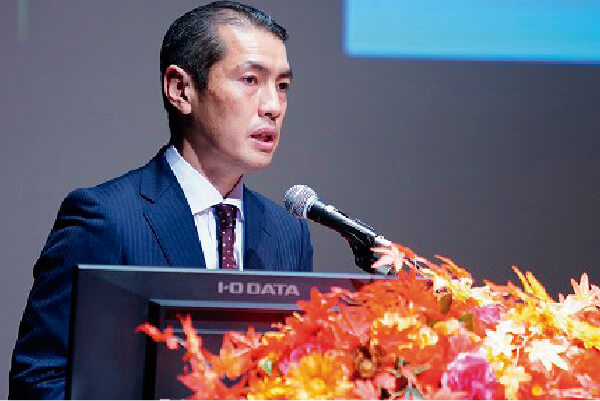
Director of Autonomous Driving and ITS Promotion Office, Automobile Division, Manufacturing Industries Bureau, Ministry of Economy, Trade and Industry Mr. Shigekazu Fukunaga
After he finished his master's at Graduate School of Frontier Sciences, University of Tokyo, he joined the Ministry of Economy, Trade and Industry in 2002. He worked as Counsellor at the Japanese Embassy in China and took his current position in July 2021.
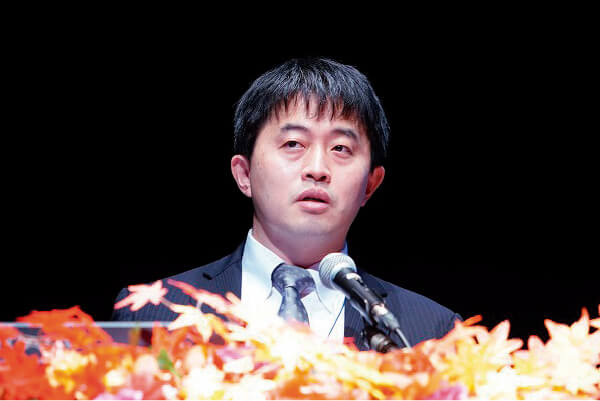
Director of New-Generation Mobile Communications Office, Radio Department, Telecommunications Bureau, Ministry of Internal Affairs and Communications Mr. Takanori Mashiko
Since joining the Ministry of Internal Affairs and Communications in 2003, he has been engaged in technology policy and radio policy making in the field of information and communications. He took his current position in July 2022.
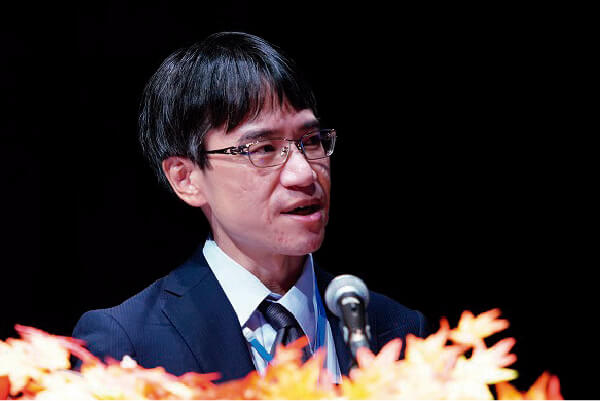
Director of ITS Policy and Program Office, Road Traffic Control Division, Road Bureau, Ministry of Land, Infrastructure, Transport and Tourism Mr. Masamitsu Waga
Joined Ministry of Land, Infrastructure, Transport and Tourism (FKA Ministry of Construction) in 1997. He took his current position in April 2022 after experiencing the chief of Urban Environment Policy Office, Urban Policy Division, City Bureau.
The final speaker of the morning session was Mr. Masamitsu Waga, Director of ITS Policy and Program Office, Road Traffic Control Division, Road Bureau, Ministry of Land, Infrastructure, Transport and Tourism (MLIT), who gave a special lecture entitled “Efforts of the Road Bureau of the MLIT regarding autonomous driving”. He explained the approaches and exit strategies for autonomous driving for each of logistics/mobility services and owner cars, and the current status of autonomous driving technology and government goals for them. The government goals include realization of autonomous driving services using only remote monitoring by FY2022, and the Level 4 autonomous driving of private vehicles on expressways by FY2025. Then he introduced the current situation and issues in hilly and mountainous areas, and as a solution, short-term and long-term autonomous driving service demonstration experiments in hilly and mountainous areas from FY2017, and social implementation based on these (based at Michinoeki, roadside stations in four prefectures of Akita, Shiga, Fukuoka, and Shimane) with video. After touching on the issues related to autonomous driving that emerged through these demonstration experiments, he explained the changes related to the installation of automated operation assistance facilities and objects for exclusive use in response to the revision of the Road Act, etc. (2020). In addition, he mentioned support measures such as the Comprehensive Subsidy for Social Infrastructure Development for local governments' efforts to develop communities using autonomous driving technology, and the loan for the construction funds to install automated operation assistance facilities to private businesses. In addition, as the development of autonomous driving services in various regions, he listed up the characteristics of a variety of "downtowns" and countermeasures for each. As specific examples, he discussed public-private joint research on roadside sensor technology for general roads, support for autonomous driving by providing information at expressway junctions, management levels of lane markings compatible with autonomous driving, and methods for providing road traffic information.
The first special lecture in the afternoon was given by Mr. Yoshitaka Tada, Director of Autonomous Driving Strategy Office, Road Transport Bureau, MLIT on "Efforts toward the realization of autonomous driving". First, he outlined the significance of autonomous driving, definition of each level of autonomous driving, current status of autonomous driving technology for each of "owner car" and "mobility services" according to each level (practical application or commercialization stage up to the Level 3, development stage for the Level 4), and issues in realizing the Level 3 (signal recognition, driving space recognition, etc.), and MLIT's efforts to address this (government goals and achievements in each implementation field). Subsequently, regarding private vehicles, he talked about the revision of the Road Transport Vehicle Act (2019) to support the use of systems driving on behalf of the driver, the safety standards for "automatic operation devices" added there, and the type designation of the world's first autonomous vehicle (expressway Level 3) (2020) based on them. He then suggested that the ministry would contribute to the study into formulating more advanced international standards through the UNECE World Forum for Harmonization of Vehicle Regulations (WP.29). Moreover, for mobility services, mentioning autonomous driving demonstration experiments being conducted throughout Japan, he talked about the implementation of vehicle performance tests at various research institutes to aim at relaxing the standards under the Road Transport Vehicle Act regarding demonstration experiments, the development of guidelines for "Last Mile Autonomous Vehicle System", and the approval of Eiheiji Last Mile Autonomous Vehicles (Level 3) through them. He also mentioned research and consideration for formulating legal requirements for the Level 4.

Director of Autonomous Driving Strategy Office, Road Transport Bureau, Ministry of Land, Infrastructure, Transport and Tourism Mr. Yoshitaka Tada
Joined the Ministry of Transport (currently the Ministry of Land, Infrastructure, Transport and Tourism) in 1998. After working as the director of Recall Enforcement Office, Road Transport Bureau, he has been in his current position since July 2020.
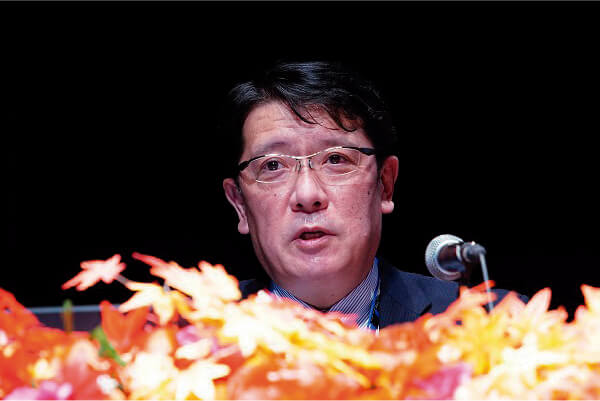
Director of Autonomous Driving Planning Office, Traffic Planning Division, Traffic Bureau, National Police Agency Mr. Kenichi Ito
He joined the NPA in April 1990. After experiencing the chief of Traffic Enforcement Division of Aichi Police, Assistant chief of Traffic Planning Division (ITS) and Investigator of Finance Division of NPA, he took his current position in August 2021.
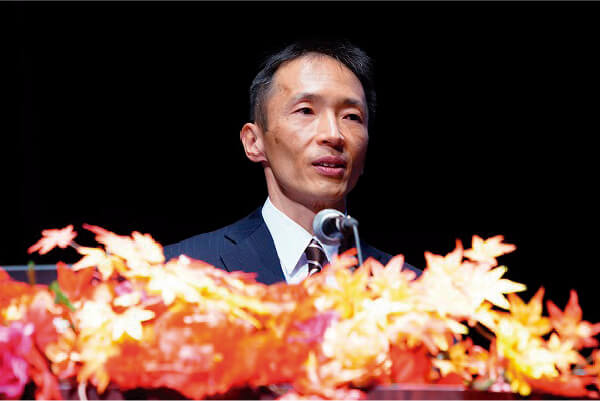
Planning Officer, Mobility Team, National Service Group, Digital Agency Mr. Takahiro Suzuki
After joined the Ministry of Transport (currently the Ministry of Land, Infrastructure, Transport and Tourism) in 1998, Mr. Suzuki was engaged in traffic administration, regional development, and international cooperation. In September 2021, he took his current position at the time of establishment of Digital Agency.
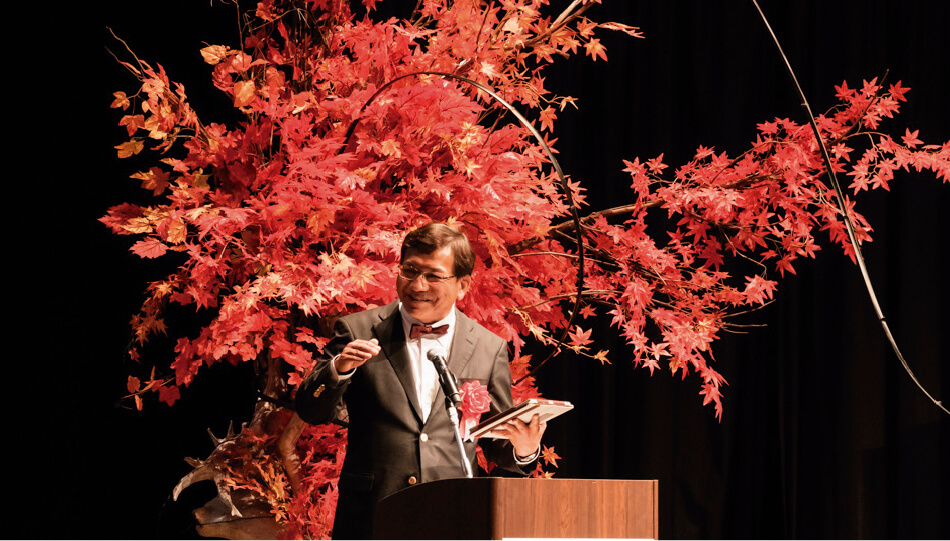
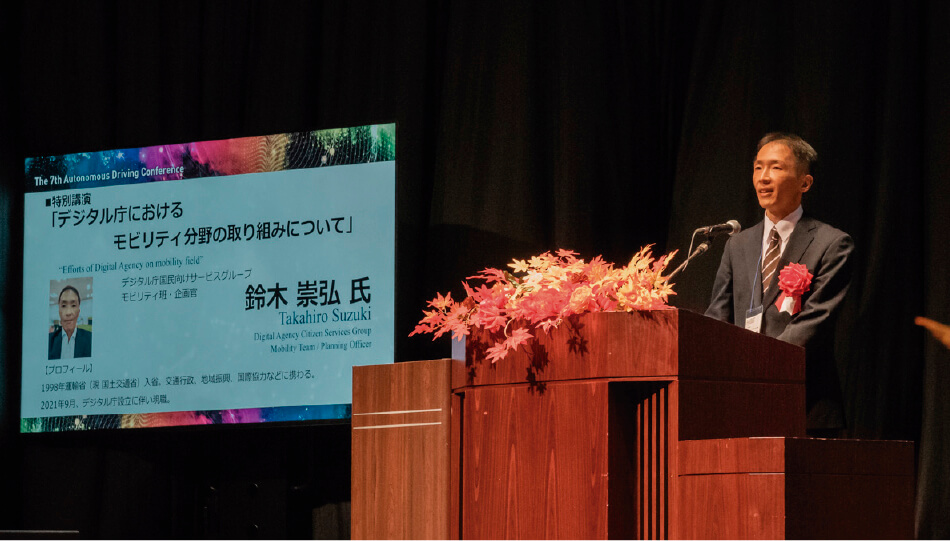
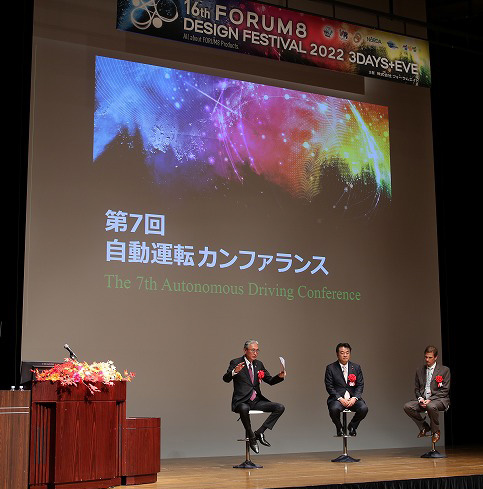
Next, Mr. Kenichi Ito, Director of the Autonomous Driving Planning Office, Traffic Planning Division, Traffic Bureau, National Police Agency (NPA), gave a special lecture entitled "Police efforts toward the realization of autonomous driving". He began by outlining the traffic accident situation in Japan, the main effects expected from autonomous driving, and the levels of driving automation. Regarding development of the NPA's legal system, he mentioned that NPA has been studying and continuously working toward the realization of autonomous driving based on the government's goal of "Future of Digital-powered Transportation Society 2022" (inheriting the "Public-Private ITS Initiative/Roadmaps 2020" from August 2022) and technological development. He then enumerated as efforts by the police related to autonomous driving development of traffic rules, development of the demonstration test environment, public relations and awareness-raising, and research and development. Among them, regarding development of traffic rules, he first mentioned the definition of automatic operation devices in the Road Transport Vehicle Law, and then explained the following items based on the revision of the Road Traffic Act: 1) Establishment of a system for the practical application of the Level 3 autonomous driving (2019), and 2) Basic concept of the permit system for the Level 4 autonomous driving, establishment of a permit system for specified autonomous driving based on it (2022), involvement of stakeholders of the system, and operation image. He said that the development of the demonstration experiment environment is basically based on the "Guidelines for Public Road Testing of Automated Driving Systems" (formulated in 2016). He also expounded the procedure for obtaining road use permits for Public Road Testing of remote autonomous driving systems and vehicles with special equipment, and "Road use permit standards for Public Road Testing of specified automated delivery robots and so forth" (formulated in 2021). He also emphasized the need to raise public relations and awareness to prevent overconfidence in driver assistance technology.
The last special lecture of the conference was given by Mr. Takahiro Suzuki, Planning Officer, Mobility Team, National Service Group, Digital Agency, who participated the Conference for the first time, on "Efforts of Digital Agency on mobility field". He organized the roles of concerned ministries and agencies related to autonomous driving or MaaS (Mobility as a Service), and the position of the Digital Agency (established in September 2021, succeeding the former National Strategy Office of Information and Communication Technology of the Cabinet Secretariat), which is responsible for planning and comprehensive coordination of basic policies. He outlined the "Public-Private ITS Concept and Roadmap" that has been formulated every year from 2014~2021, the latest key goals to realize indicated in it, and the results of efforts toward the practical application of autonomous driving so far. He then mentioned the direction of the "Future of Digital-powered Transportation Society," which took over the roadmap in a progressive manner, as well as the background and awareness of issues (major changes in the phase of population decline, etc.). He also explained the organization of the "Study Group on the State of the Digital Transportation Society" established by the agency lately, examination of services that emphasize the perspective of daily life, and the concept of digital infrastructure development with "mutual assistance" as the keyword. Finally, with a view to the Vision for a Digital Garden City Nation, he expounded how to proceed with future initiatives reflecting these, and mainly introduced new approaches in each category, such as autonomous driving and driver support in "Future of Digital-powered Transportation Society 2022", road space and MaaS, drones and flying vehicles, and cooperative areas in the mobility field (data linkage in the mobility field, 3D spatial information infrastructure, etc.).
In response to these lectures, in the first half of the closing of the Conference, FORUM8's representative gave a presentation entitled "Autonomous driving and MaaS solution accelerated by DX – 3D VR software realizing digital twins -". He focused on building environments for digital twin (DT) for autonomous driving and MaaS and utilization of them and solutions using WebVR that can be run in a web browser. First, he introduced a variety of basic functions of simulation from a driver's point of view driving on a DT built using UC-win/Road Ver.16. He further explained the availability of PLATEAU (a project for developing, utilizing, and creating open data of 3D urban models led by MLIT) and point cloud data being developed by local governments, and their possibilities of facilitating and expanding DT construction over a wide area by linking with UC-win/Road. He also mentioned the real-time linkage function between UC-win/Road and the traffic simulation system "VISSIM" and the understanding of the impact of new mobility interventions using an environment that generates vehicle trajectories with time history from images. Additionally, he talked about the possibilities of constructing types of systems centered on UC-win/Road, built-in supporting, building an experimental environment for VRDT in cooperation with autonomous driving control systems and their application examples, and creating WebVR using F8VPS. He also mentioned UC-win/Road Autonomous Driving/ADAS Packages, various driving simulators, the latest features of Shade3D and Suite Chidori Engine, and the efforts of the metaverse "Virtual FORUM8 Rally Japan 2022" with F8VPS.
Finally, from the perspective of FORUM8’s development staff, a presentation was given with a title of "Latest information on FORUM8’s VR solution – New normal of VR simulation -". First, he explained the new features of UC-win/Road Ver.16 (released in May 2022) such as ASAM OpenDrive support, CityGML city model import, addition of multi-user scenario function, enhancement of VISSIM linkage function, expansion of road modeling function, and performance improvements. At the same time, he indicated that various modeling and simulation functions would be enhanced in UC-win/Road Ver.17 (scheduled for release in March 2023), which is under development. Then he introduced the development concept and functions of F8VPS, examples of its use, the next-generation communication platform using XR technology challenged in 2022 as part of this, the design festival metaverse built for DF of this year, and the VR site of aforementioned FORUM8 Rally Japan. He also showed his idea about future development.
(Translation up to this part is written by Takashi Ikeno)
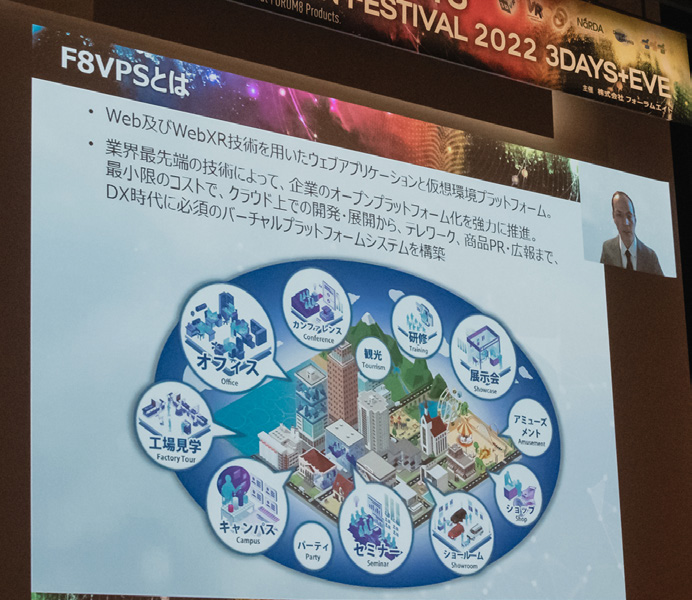
Presentation 1 "Autonomous driving and MaaS solution accelerated by DX - 3D VR software realizing digital twins -"
FORUM8 Executive Officer, System Sales Manager
Katsumi MatsudaPresentation 2 "Latest information on FORUM8's VR solution - New normal of VR simulation -"
FORUM8 Executive Officer, Development Senior Manager
Pencreach Yoann -
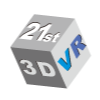 The 21st 3D VR Simulation Contest on Cloud Awards Ceremony
The 21st 3D VR Simulation Contest on Cloud Awards CeremonyFocusing on the Use of Digital Twins, with "VR SYSTEM OF THE YEAR" Newly Established
In the second half of the afternoon session of Day 1, the awards ceremony was held for the "21st 3D VR Simulation Contest on Cloud", which competed for VR works created by making full use of VR solutions from FORUM8, including UC-win/Road. Out of a large number of entries received by October 17, 12 works were nominated after the Nomination Work Screening on October 26. General Voting was held to vote for them from November 7th - 13th using VR-Cloud®. Taking these scores into account, the awards were decided on November 15 in the meeting for Award Winning Selection (held at FORUM8 Tokyo Head Office), which consisted of three members: Prof. Fumio Seki as Jury Chair, Professor, Department of Civil Engineering, College of Science and Technology, Nihon University; Mr. Hiroo Kasagi as a juror, Representative, NPO Community Development Studio, and Prof. Tetsunori Haraguchi as a juror, Visiting Professor, Institutes of Innovation for Future Society, Nagoya University.
As a result, the Grand Prix (Grand Prize) was won by TAISEI CORPORATION's "3D Real-Time Digital Twin System for Heavy Machinery in Dam Construction Work". By linking the cooperative control system of the automatic construction machinery with UC-win/Road, a real-time 3D monitoring system and an emergency stop system in case of workers approaching the machinery at the dam construction site are built up. Using position information of GNSS, positions of the automatic construction machinery and workers are visualized on UC-win/Road to detect their approaches. It is so mechanized as to warn the supervisor of the automatic construction machinery or order the cooperative control system to stop depending on the situation. The award-winning work was highly evaluated as an excellent example of utilizing digital twin, which integrates and manages different types of heavy machinery, dump trucks and workers in real time at ever-changing sites (by Mr. Seki).
The Second Prize (Excellence Award) went to "Simulation to Experience the Effect of Seismic Isolation and Vibration Control Devices" by NIPPON STEEL ENGINEERIG CO., LTD. This is to experience the effect of the devices for seismic isolation and vibration control that reduce damage to buildings in the event of an earthquake. They reproduced spaces such as warehouses, condominiums, and offices, and created a sense of realism with physics simulations of things tipping and falling, as well as sound effects. It allows users to experience the difference among structures of earthquake resistance, seismic isolation, and seismic control by VR and the motion seat via HMD. It was appraised by Mr. Haraguchi that they used UC-win/Road in a way to expand its framework, for example, using the waveform of the actual vibration as a basis, in order to reproduce the vibration more realistically.
What's more, from this time, the "VR System of the Year" has been newly established, which focuses on systems that contribute to promotion of DX using VR. It is judged by the VR Promotion Council, which not only helps development and provision of a platform using VR, but also encourages various industrial fields to use it in cooperation with local governments. The award for this first year was given to the Ministry of Land, Infrastructure, Transport and Tourism (MLIT)'s "Construction DX Challenge (Remote Construction Demonstration) Digital Twin System". The DX experiment field in the "VR NILIM" (built up with F8VPS) was updated, where a virtual venue for demonstrations of remote construction was built in. In addition to reproducing the venue layout of the demonstration and heavy machinery moving at the actual site in the VR space, the video of the actual construction site was also live-streamed. It was developed as a digital twin platform capable of obtaining information from the heavy machinery sensor and simulating the operation of heavy machinery synchronized with the actual construction site. It was highly evaluated that the public-private use of the systems that promote DX through the application of VR can be expected (commented by Yuji Ito, President of the Council).
(Translation up to this part is written by Takashi Ikeno)
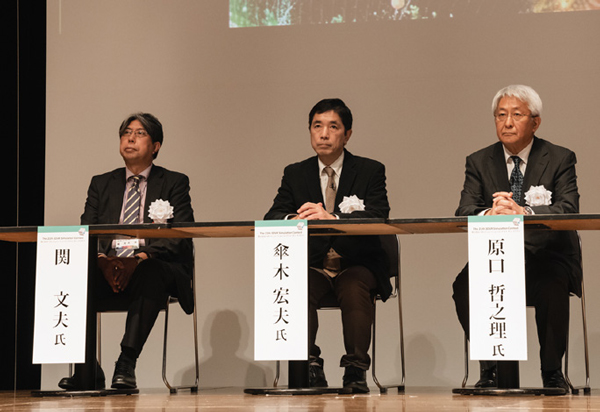
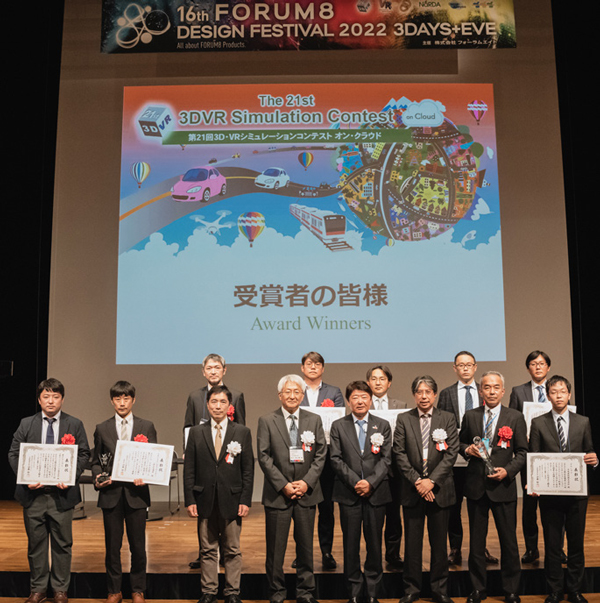
DAY2 2022.11.17THU REPORT
Lecture Material / Movie
Lecture Material / Movie
-
 The 23rd UC-win/Road Conference
The 23rd UC-win/Road Conference"New functions of Shade3D, application to Metaverse, utilization of Suite Chidori Engine"
FORUM8 Shade3D Development Group
Keisuke MikuriyaFocused on the evolution of UC-win/Road and F8VPS and the development of metaverse and AI application
Day2 (Nov. 17th, 2022) got started with the opening speech by Yuji Ito, President and CEO of FORUM8. It was followed by a presentation "New functions of Shade3D, application to Metaverse, utilization of Suite Chidori Engine" by a FORUM8 developer. He introduced the basic functions of Shade3D as well as the new functions of its Ver.23 such as road alignment, morph target supporting metaverse, and improvement of animation by multi-timeline support. As development tools for Shade3D, he explained new functions of Block UI Programming Tool and animation block used for education and Shade3D SDK corresponding to advanced plug-in development by using C++ language. As for the future development toward the application to metaverse, he also explained that FORUM8 is strongly promoting the creation of open platforms with F8VPS and that 3D models in glTF and FBX formats created with Shade3D can be used in metaverse spaces. In addition, he talked about the products and services to support data creation, such as the practical 3D data collection and CG input support service.
At last, "Suite Chidori Engine", the Japan-made cross-platform 3D game engine where Shade3D data can be utilized was introduced including its newest features and game examples developed with it.
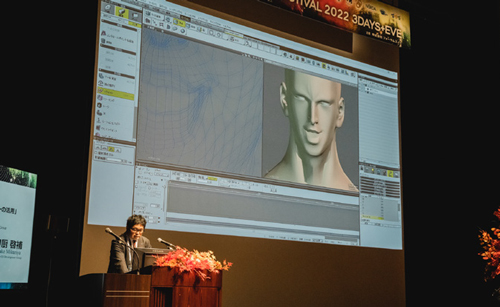
Explanation of the new functions of Shade3D

Models created with Shade3D can be used in metaverse.
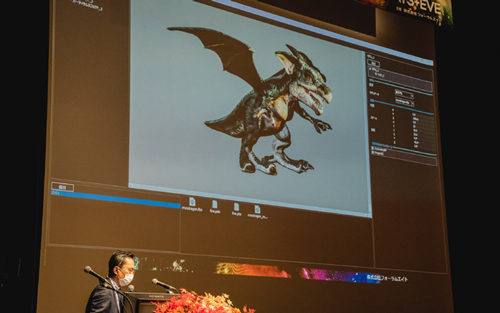
New features and sample games of Suite Chidori Engine
-
Special Session
"A way of thinking to change design from its essence"
Professor Emeritus, Tohoku University
Dr. Yoshiyuki KawazoeThe power of design to capture the essence of what is important in a society seeking sustainability
The first half of the afternoon session of Day2 opened up with a special lecture "A way of thinking to change design from its essence" by Dr. Yoshiyuki Kawazoe, Professor Emeritus, Tohoku University. He explored the background to EV, solar power and the SDGs, which are now becoming mainstream, and explained the importance of thinking about essential changes for a prosperous society. Changes in the processing speed of computers and supercomputers as an example, he explained the importance of pursuing quality rather than quantity, and that high-quality results have economic and monetary added value. To pursue quality needs to see and think, but the human brain and eye have illusions and blind spots. He demonstrated it using examples of the silhouette illusion and prism spectroscopy.
He also stated that Japan tends to accept concepts from the West, such as the SDGs, as they are, but that it is important to be aware that the concept of a sustainable society, which lasted more than 10,000 years during the Jomon period, has been inherited in present-day Japan, and to create new values by making use of the characteristics of our own civilization.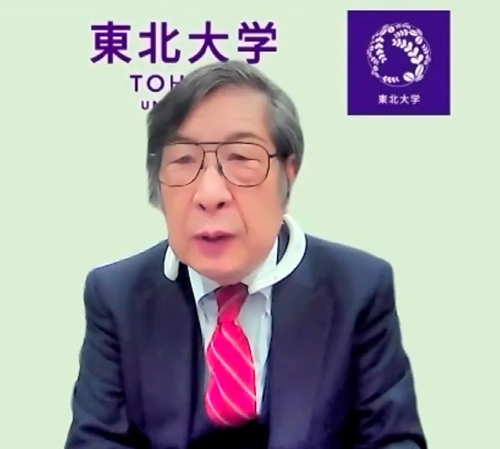
Professor Emeritus, Tohoku University Dr. Yoshiyuki Kawazoe
Professor Emeritus of Tohoku University, Distinguished professor of Suranaree University of Technology, Thailand, Founder of Asian Consortium on Computational Materials Science, CEO of Professor Emeritus.com
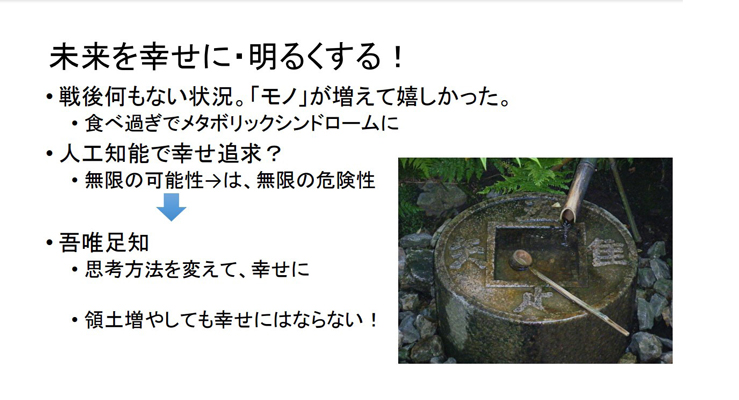
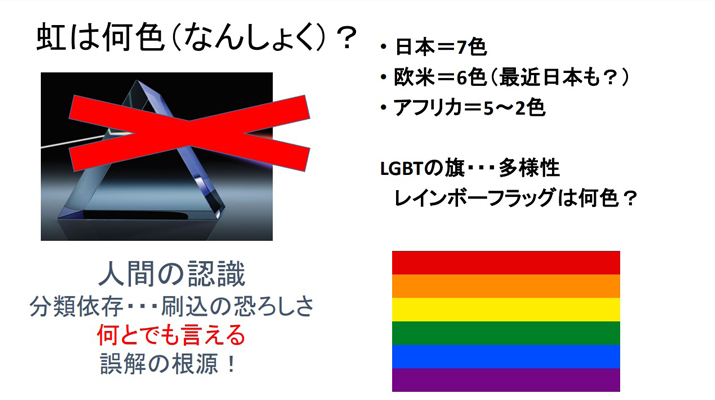
-
 The 15th International VR Symposium
The 15th International VR SymposiumAdvanced proposals for the use of VR technology were presented by researchers from different countries.
In "The 15th International VR Symposium", Dr. Yoshihiro Kobayashi (Arizona State University), the host of the symposium and the representative of World16 introduced the overview of projects by World16, which is consisted of researchers at universities in several countries who are utilizing VR in the fields of architecture, civil engineering, and city planning. Then he looked back the annual summer workshops and symposiums, and each member of World 16 did presentations on their most recent research work.
The symposium started with the presentation titled "Possibility of automatic 3D data creation using AI" by Prof. Tomohiro Fukuda (Osaka University). He introduced the potential for future automatic generation of 3D data for VR architecture and cities using AI trained to automatically generate depth information from a single image. In addition to the restoration of 3D models using neural networks and the creation of design concepts using diffusion models, he talked about the possibility of using the technology of automatic creation with generative models for easier construction of metaverse and for creation of 3D virtual environment models for alignment.
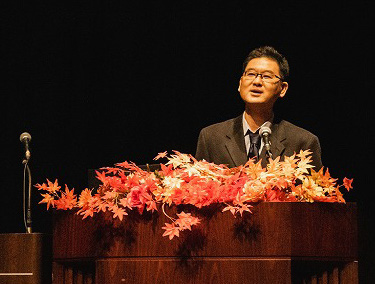
Arizona State University, Dr. Yoshihiro Kobayashi
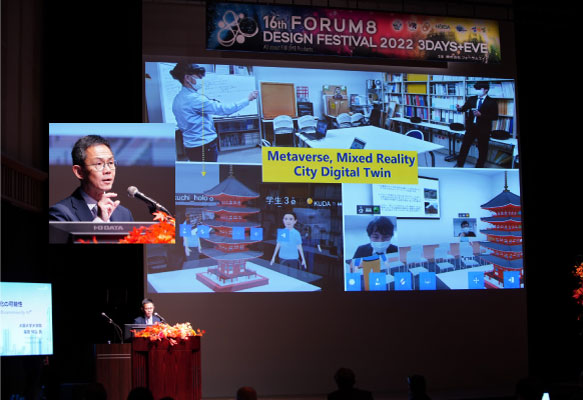
Graduate School of Osaka Univ. Prof. Tomohiro Fukuda
Next, Prof. Rebeka Vital (Shenkar College of Engineering, Design and Art, Israel) presented her work "Development of light distribution simulation tool for VR space". The tool can load IES files (light distribution data) used in lighting equipment into VR space and output scientific data on how road surfaces and buildings are illuminated. She explained that by quantifying the degree of illumination, she created an IES file and linked it to UC-win/Road, and by color-coding the degree of illumination, it was possible to see the situation at each spot.
Prof. Marc Aurel Schnabel (Victoria University of Wellington, Faculty of Architecture) and Prof. Thomas Tucker (Virginia Tech.) presented their development of a tool to provide VR contents at NFT market. They created a template to design rally cars of WRC, which FORUM8 supports as the title partner, so that anyone can design 3D models of vehicles and provide them at the NFT market. After creating a 3D model of a WRC rally car, they changed the textures and coloring of the parts using variables. Then they created it as NFT, downloaded it to use in Metaverse or output with 3D printer, or exported the models to game engine to make animation. Through these activities, they also proposed the future use of NFT contents on the Web VR Platform F8VPS.
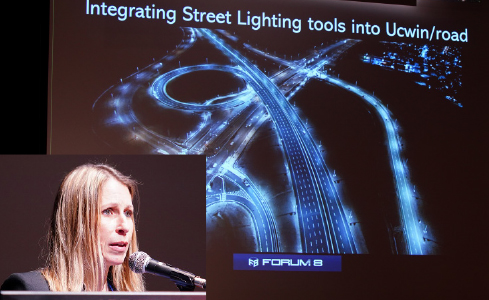
Shenkar College of Engineering, Design and Art, Prof. Rebeka Vital
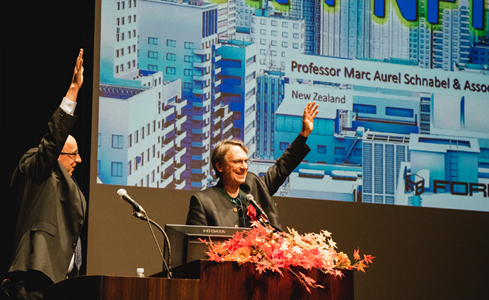
Victoria University of Wellington, Prof. Marc Aurel Sclnabel
Virginia Tech. Prof. Thomas Tucker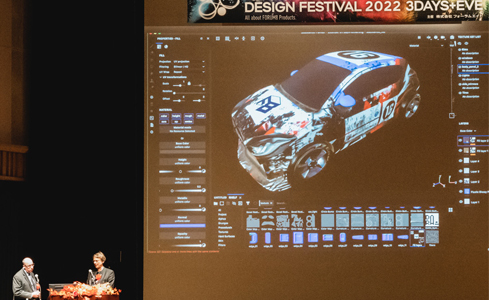
The presentation by Prof. Matthew Swarts (Georgia Tech.) was about the development of a system and device for driving training and simulation of large trailer that requires skills for driving. The driving evaluation simulation system could detect ideal driving and provide feedback and quantification of steering wheel, gas pedal, brake, speed, etc. He explained that it is also possible to quantify and display scores from log information using UC-win/Road's API.
Prof. Kostas Terzidis (Tongji University, Design Creative Academy) presented "AI For Kids". Based on his experience teaching a class on AI to children at his university, he introduced the creation of a development tool for children that would allow them to convert images of scenery seen from car in real time through the use of AI. He proposed a tool that would allow children in the backseat to see a scenery as if they are moving through a creative virtual space of their own making and stated that using new technology in this way to create their own imaginary world and walk around in it is a way to achieve virtual happiness and to make people happy.
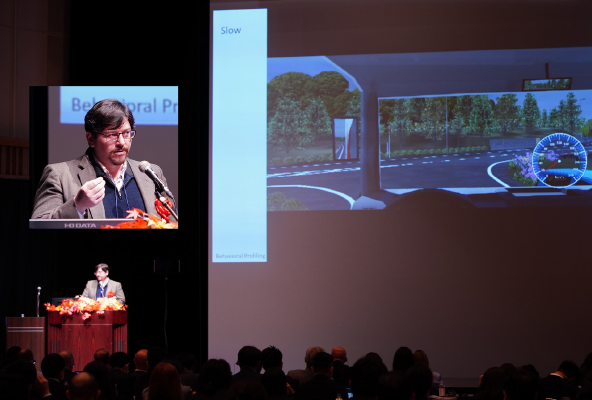
Georgia Tech. Matthew Swarts
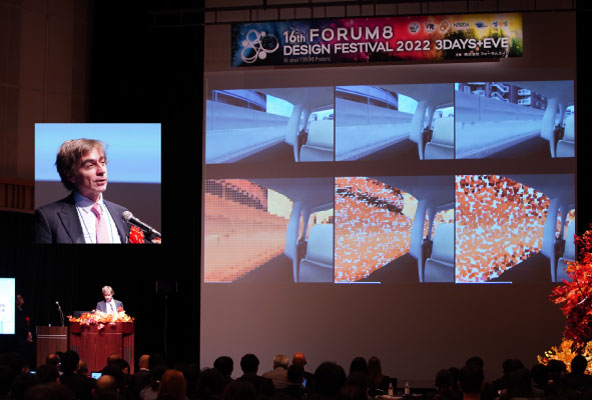
Tongji University, Design Creative Academy, Kostas Terzidis
Prof. Paolo Fiamma (University of Pisa), who researching integrated design approaches for sustainable smart cities and CO2 reduction and is working on a project in collaboration with the city of Pisa, presented the collaboration between FORUM8's BIM/CIM tool (UC-1), VR tool (VR Design Studio UC-win/Road) used for verification of design data and construction process, and CG tool (Shade3D) to create 3D data.
With regard to the activities to promote bicycle use as a new vision of mobility in Europe, he explained the need to visualize by design and understand the current situation in order to create bicycle paths and to think how to utilize them. A simulation of creating a cycle path beside the current road has shown that it does not lead to a reduction in CO2 emissions and that a balance needs to be struck.
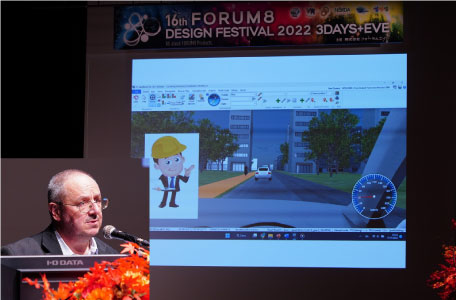
University of Pisa, Paolo Fiamma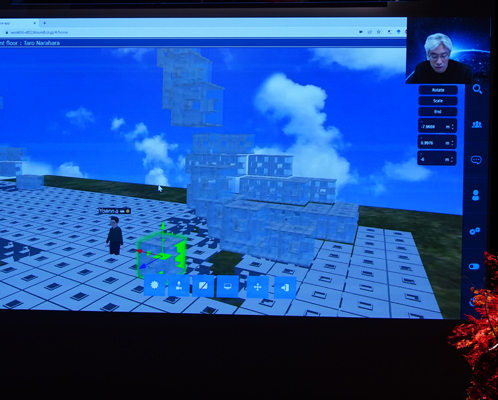
New Jersey Institute of Technology, Prof. Taro Nagahara
The presentation by Prof. Taro Narahara (New Jersey Institute of Technology) was "Development of a multi-participant design tool using F8VPS". He implemented a system so that multiple participants can edit VR data simultaneously in a cloud environment, while at the same time considering the use of the system for turn-based module placement systems and real-time crowd simulation.
Prof. Marcos Novak (University of California, Santa Barbara) constructed an environment where VR space in the cloud can be freely controlled via various external tools and devices using OSC (Open Sound Control). He explained how machines can detect and react to the state of your feelings, and how software can be linked to UC-win/Road to control daylight from a smartphone. He also mentioned that software is currently shifting towards AI-based, and that if the car becomes autonomous, the windows could become displays, receiving the user's state of mind and displaying a graphic representing that state.
Professor Ruth Ron (University of Miami) presented "Mangrove-type Future Urban Design", a project to evaluate and validate a mangrove-based water city concept using VR tools, demonstrating the potential for education in architecture and urban planning using F8VPS.
In the VR space, she explained the mangrove ecosystem while paddling in a canoe. The presentation also discussed about the use of mangrove trees and the reconstruction of a mangrove-inspired city under the assumption that Miami was flooded, which was modeled in detail and assembled in F8VPS.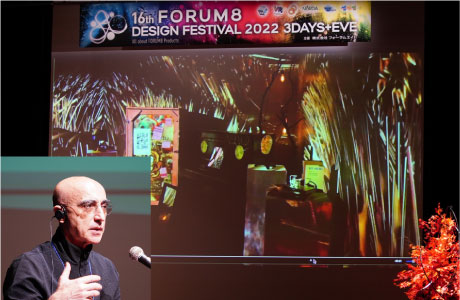
University of California, Santa Barbara, Prof. Marcos Novak
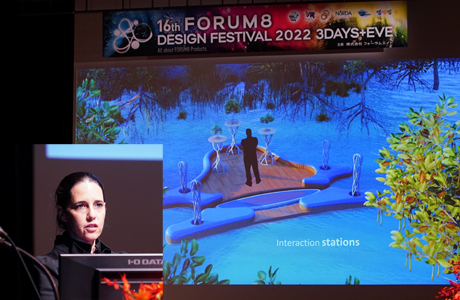
University of Miami, Prof. Ruth Ron
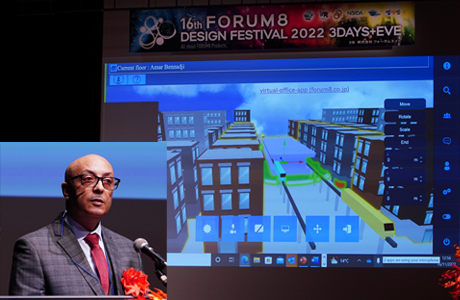
Hanze University of Applied Sciences, Prof. Amar Bennadji
Amar Bennaji (Hanse University of Applied Sciences, the Netherlands) proposed the use of the WebVR platform F8VPS in the field of environmental design, where multiple participants are simultaneously considering various aspects of the project. He explained that by using F8VPS to digitize the process of participatory operations, it is possible to exchange opinions and modify each other's models in VR, and people from other locations can also collaborate with each other.
After the presentations by each member of World16, Mr. Yoann Pencreach, FORUM8's Executive Officer and Development Senior Manager, explained how each project will be connected to FORUM8's product development, as well as specific prospects for the future. Finally, the International VR Symposium was closed with a summary by Dr. Yoshihiro Kobayashi.
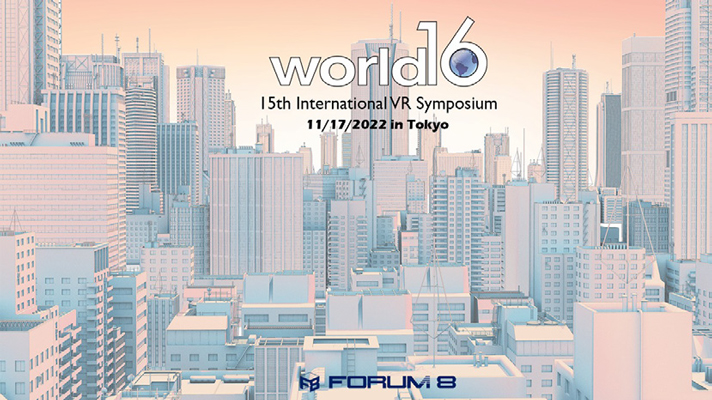
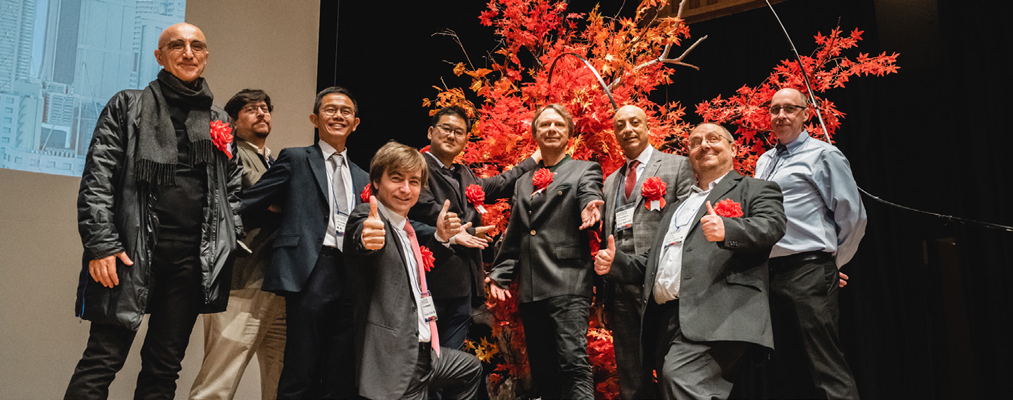
-
 The 10th Cloud Programming World Cup
The 10th Cloud Programming World Cup
Public Presentation and Awards CeremonyHigh-level projects using machine learning algorithms and other cutting-edge technologies
The 10th Cloud Programming World Cup (CPWC) was held in the morning of Day2, followed by the announcement of the winners and awards ceremony in the afternoon with Mr. Patrick Harlan aka Pakkun as the presenter. The CPWC is an international competition for cloud application programming technology using Software Development Kits. From April to June, many entries were entered from across Japan and abroad, mainly from Asia. On July 12th, all juries gathered at FORUM8 Tokyo Head Office and selected 24 teams to pass the 1st round selection meeting. From among the works submitted by the teams passed in October, 8 works were nominated after nomination selection. Based on each team's presentation during the final judging on November 17th, the open final judging was held with juries: Prof. Tomohiro Fukuda (CPWC Head Judge / Assoc. Prof., Graduate School of Engineering, Osaka University), Prof. Makoto Sato (Professor Emeritus of Tokyo Institute of Technology), Prof. Taro Narahara (Assoc. Prof., College of Architectural Design New Jersey Institute of Technology), Mr. Yoann Pencreach (Executive Officer and Development Senior Manager of FORUM8).
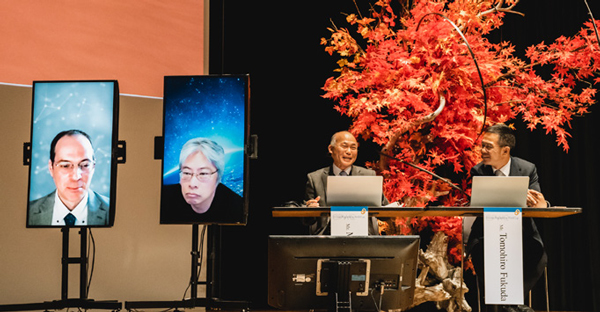
Juries (from the right): Prof. Tomohiro Fukuda, Prof. Makoto Sato, Prof. Taro Narahara, Pencreache Yoann
The Grand Prix was given to "TAP(Traffic Accident Prediction)" by KAAD (Kookmin University, Korea). This work aims to build an abnormal detection model to prevent accidents and support safe driving. Object positions and optical flows are extracted from UC-win/Road and input into an anomaly detection model in the PyTorch environment. The system learns abnormal detection models using normal data through unsupervised learning to derive anomaly scores. It checks the driver's eye position with eye tracker and sends warnings as necessary. Prof. Fukuda, the jury chief, commented "the implementation of the system was excellent, and the fact that it was connected to the eye tracking system matched this year's theme of 'connecting people'. The technical level was also remarkable".
Each of 4 juries gave Honorable Judge Award to 4 teams: Prof. Fukuda to "EXTREMELY FAST RESCUE" by SOS-Team from Shanghai Univ., China; Prof. Sato to "Mobility-Support Robot for Relaxation" by MT Girls from Sugiyama Jogakuen University, Japan; Prof. Narahara to "Research on pedestrian crossing and vehicle behavior decision under automatic driving environment" by Timer from Beihang University, China; Mr. Yoann to "Nijigaku Traffic Radio" by Nijigaku from Vin University, Vietnam.
The "Academy User Introduction" in the FORUM8's PR magazine "Up&Coming" Vol.140 features Kookmin University, which won the Grand Prix in the 10th Cloud Programming World Cup for Students.
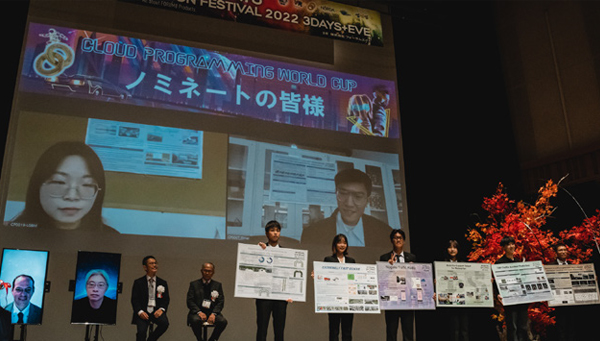
Grand Prix Awards
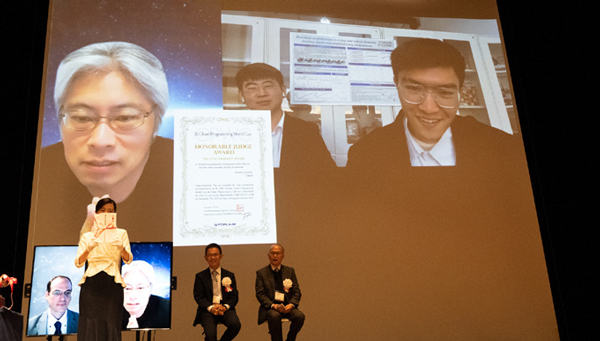
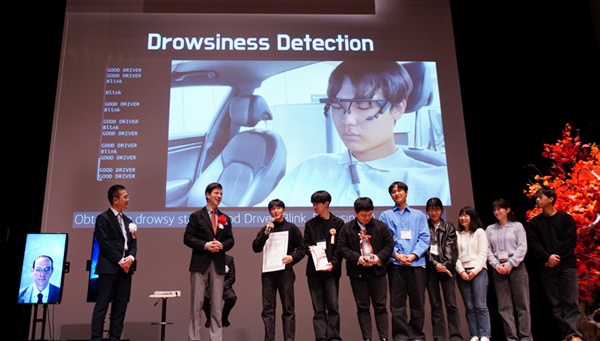
-
 The 12th Student BIM & VR Design Contest on Cloud
The 12th Student BIM & VR Design Contest on Cloud
Public Presentation and Awards CeremonyYoung Z/X generation proposed high-quality works using UC-win/Road
Following the CPWC, the final open judging and awards ceremony of the "12th Student BIM&VR Design World Cup on Cloud (VDWC)" were held. The VDWC was a cloud-based competition for advanced architectural and civil engineering design, and the theme of this year was "A City Where Humans and Smart Mobility Coexist - Western Sydney Airport Terminal Neighborhood". Like the CPWC, 7 entries were nominated through a process of entry (31 teams), preliminary selection, and nomination judging. After the presentation on Day2, 4 juries; chief Yasushi Ikeda (Project Prof., Univ. of Tokyo, Architecture Information Lab.), Prof. Kostas Terzidis (Tongji University), Prof. C David Tseng (National Yang Ming Chiao Tung University, Taiwan), and Prof. Takehiko Nagakura (Massachusetts Institute of Technology) had the open final judging.
The World Cup Award (Grand Prix) was given to "String" by Team Davinci (Keio University). The work designed an intelligent traffic system which is different from the functions of conventional terminal buildings. When passengers make a request through their smartphones, the traffic and pedestrian behavior analysis system predicts the movement situation and suggests passengers with a variety of travel options. "Airports are places where people congregate, but it's wonderful to see that they no longer need to congregate. It was a major deciding factor in how transportation and human behavior will change in the future", Prof. Ikeda commented.
Juries (from the right) Prof. Yasushi Ikeda, Prof. Kostas Terzidis, Prof. C David Tseng, Prof. Takehiko Nagakura
"Laputa" by Cloudy from National Kaoshung University, Taiwan won the Excellence Award. They aimed for the coexistence of humans and smart mobility with the intelligent integrated transportation system based on the concept of Metaverse.
Four Honorable Judge Award went to as below:
Honorable Judge Award (Prof. Ikeda) to HaloO City by Go Waka from Victoria University of Wellington (New Zealand), Honorable Judge Award (Prof. Terzidis) to HEXAGON AEROTROPOLIS CITY by TEAM AURORA from Technological University (Hmawbi) (Myanmar), Honorable Judge Award (Prof. Tseng) to AMT -AIR MOBILITY TERMINAL- by Team CST from Nihon University (Japan), Honorable Judge Award (Prof. Nagakura) to Ethereal Happiness by Unicorns on Top from VNU University of Engineering and Technology (Vietnam)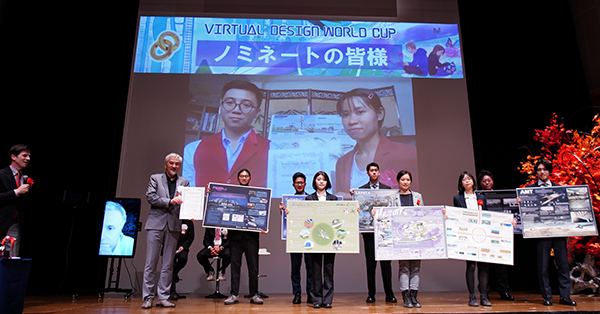
Grand Prix Awards
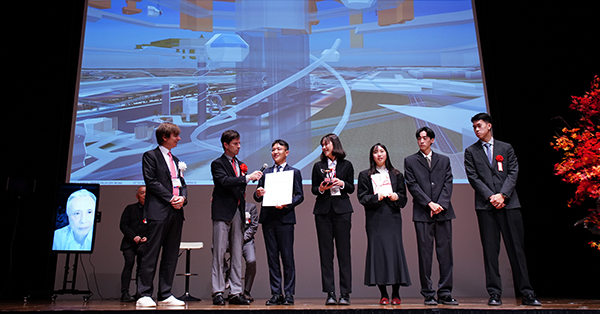
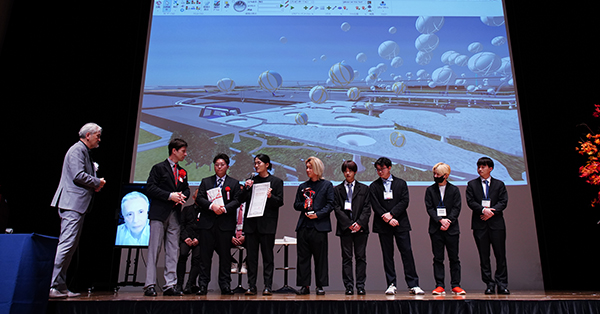
-
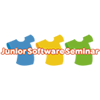 The 8th Junior Software Seminar Awards Ceremony
The 8th Junior Software Seminar Awards CeremonyChildren's bold and unique ideas were expressed with the functions of UC-win/Road.
The final session of Day2 was the Awards Ceremony of "The 8th Junior Software Seminar". VR works created through "Junior Software Seminar" held for elementary and junior high school students during each vacation in winter, spring, and summer were introduced and honored.
In 2022, 6 Gold Prizes, 12 Silver Prizes and 11 Bronze Prizes were given to the participants. The children attended both at the venue and online, and Mr. Pakkun (Patrick Harlan) and Ms. Kaltida Tada progressed the ceremony with their skillful way of speaking, including work introduction, award giving, and interview. A long roller coaster ride on the ocean where a school of giant squid is swimming side by side, a railroad in a submerged city, and a world where spring, summer, fall, and winter blend together are just a few examples of the bold and unique ideas of children that have been expressed to the fullest extent possible using UC-win/Road's functions.
(Translation up to this part is written by FORUM8)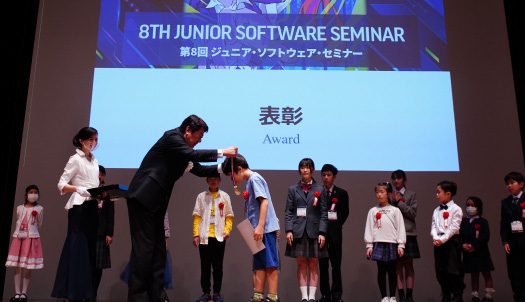
Awarding of certificates and group photo
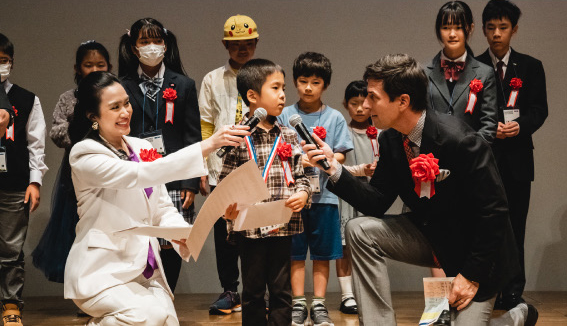
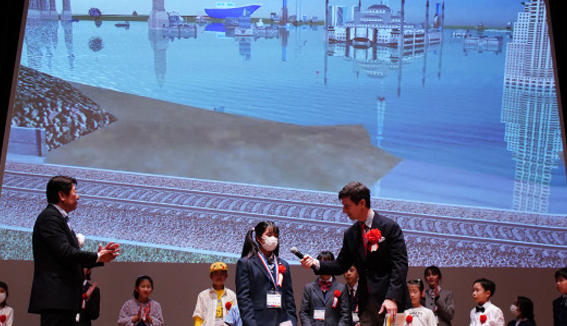
DAY3 2022.11.18FRI REPORT
Lecture Material / Movie
Lecture Material / Movie
-
 8th State of the Art Technologies in Expression Association / Latest Technology Art Session
8th State of the Art Technologies in Expression Association / Latest Technology Art Session
6th Hagura AwardA number of unique works tackling cutting-edge expressions of image and sound
Greeting from Chairman
Chairman for the State of the Art Technologies in Expression Association
Mr. Akira Hasegawa"The 8th State of the Art Technologies in Expression Association & Latest Technology Art Session" opened up with the opening speech by Mr. Akira Hasegawa, the chairman for the State of the Art Technologies in Expression Association. He also introduced the association's activities such as Digital Kakejiku Project "DKFORUM8" sponsored by FORUM8, and other activities of the Association such as Examination for Competency in Expression Technology, including its new category "Cloud - AI".
Next, the Award Ceremony of The 6th Hagura Award was held. Among many entries, the awards were given to 7 works through the judgment in October: 1 Hagura Award, 1 Company Award (DKFORUM Award), 2 Excellence Award and 3 Encouraging Award.
Hagura Award was given to "Personal Naked Eye Stereoscopic Viewing System based on Anamorphosis" by Fujishiro Lab., Dept. of Information and Computer Science, Faculty of Science and Technology, Keio University (recommended by Information Processing Society of Japan). Utilizing "anamorphosis", a classical optical illusion technique in which the correct projected image is obtained only from a specific viewpoint, the laboratory designed a stereoscopic viewing system that easily induces motion parallax by tracking the viewer's perspective through a webcam on two display monitors, and recalculating and presenting it in real time. It is very important to consider visual information on the human side to realize comprehensive visual computing, and this is a symbolic example of skillfully combining HPUs (Human Processing Units) in addition to fastest-growing CPUs and GPUs.
FORUM8 DKFORUM Award went to "D-K AMP" by U+ (recommended by State of the Art Technologies Expression Association). This work amplifies digital hanging scrolls by mirror reflections to create a sphere-forming image that floats in space. It is produced as a project that can be used at various events as an image-generating device.
Moreover, "Ultra-realistic communication technology Kirari!" by NTT Human Informatics Laboratories (recommended by Ultra-Realistic Communications Forum) and "PythagoraSwitch with immersive sound" by NHK Science & Technology Research Laboratories (STRL) (recommended by Ultra-Realistic Communications Forum), and many more unique works handling the cutting-edge expressions of image and sound were presented.
(Translation up to this part is written by FORUM8)
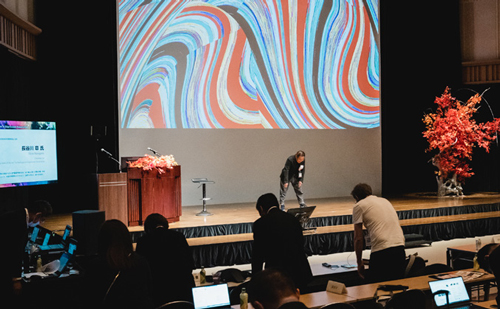
Mr. Akira Hasegawa introduced the activities of the State of the Art Technologies in Expression Association, including digital hanging scrolls, in his greeting speech.
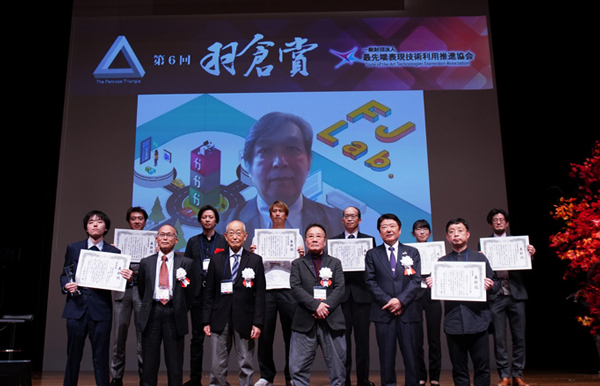
Award winners of Hagura Award
-
 15th Design Conference IM&VR・i-Construction Session
15th Design Conference IM&VR・i-Construction Session"Numerical analysis of collapse process for RC structures and environmental impact -Collapse Process, Gravelization, and High-Temperature History of Fire-"
College of Urban Sciences, Yokohama National University
Prof. Koichi MaekawaVarious Approaches to Gravelization of Concrete Structures, Utilization of 3D Nonlinear Analysis
The first half of the afternoon session started with a special lecture to start the 16th Design Conference by Prof. Koichi Maekawa, Institute of Urban Innovation, Yokohama National University, entitled "Numerical analysis of collapse process for RC structures and environmental impact: Collapse Process, Gravelization, and High-Temperature History of Fire". While saying that dealing with "gravelization" of concrete structures will be an issue in the infrastructure field in the future, he also points out that Gravelization has both merits and demerits. He explains that it is "Engineering" that controls this well, and for that purpose, it is necessary to have the three-dimensional state of the structure correctly as a base.
Therefore, after mentioning recent rapid progress in 3D nonlinear analysis technology as an introduction to the lecture, he explained the application examples of 3D nonlinear analysis to various designs that he has focused on in the past 1~2 years as follows: 1) Advanced use of RC nonlinear analysis technology in the design of LNG underground tanks and analysis of its cost-saving effects, 2) Investigation of structural weaknesses through evaluation of seismic performance of tunnel sections including heterotypic multi-sections of the railway system, 3) Analytical study of the design and construction of the underground station of Linear Chuo Shinkansen (maglev bullet train) to be built deep underground in close proximity to existing Shinkansen and stations, 4) Latest technological breakthroughs through comparison of verification experiments during between 2000 and 2021 for the topic, "The face with the largest deformation in the orthogonal direction of the crack dominates the overall nonlinear (active crack), while the others are dormant cracks."
Subsequently, he explained conversion to gravel and sediment of floor slabs, which is one of the manifestations of the collapse of concrete structures; acceleration of this event by water and the difference depending on the conditions; influence of accumulated water on floor slab life and life estimation approach based on it; and verification of mathematical model based on the actual floor slab management data. Next, he further expounded the relationship between concrete strength and shear force, binding force, hardened cement, and gravelization in the collapse process of shear transmission mechanism. In particular, to evaluate that "the concrete converted into gravel is stronger when there is high binding force", he presented his view that the collapse process can be accurately obtained by considering the concrete model together with sand and gravel models if any, in three dimensions.
In addition, taking examples such as deterioration of friction surfaces and transition to gravel aggregation, softening and collapse processes after exceeding bearing capacity, Extension to brickwork structure and verification of gravelization model, application of gravelization model to the interaction between faults or fracture zones and underground structures, possibilities in the maintenance of underground structures, evaluation of the residual performance of concrete structures damaged by fire and early restoration, he gave detailed explanation with the results of experiments and analyses. Finally, he gave his thoughts that even though there are things not visible in the world of statistics (statistical data, past experience, history, etc.) or the digital world (evaluation of life and strength by numerical scientific methods) respectively, overlapping the two allows what can be seen to be deepened.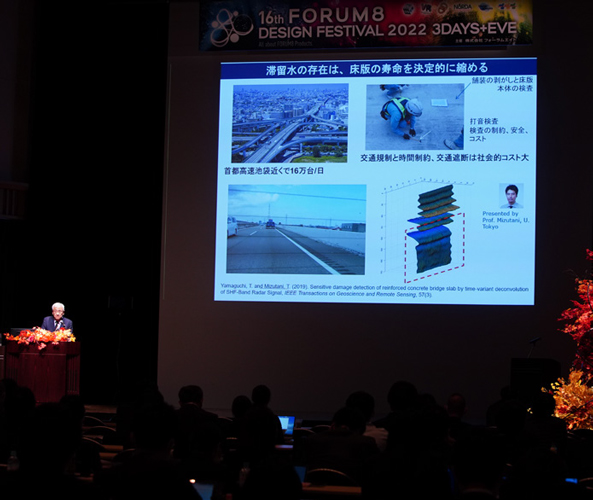
Prof. Koichi Maekawa, College of Urban Sciences, Yokohama National University
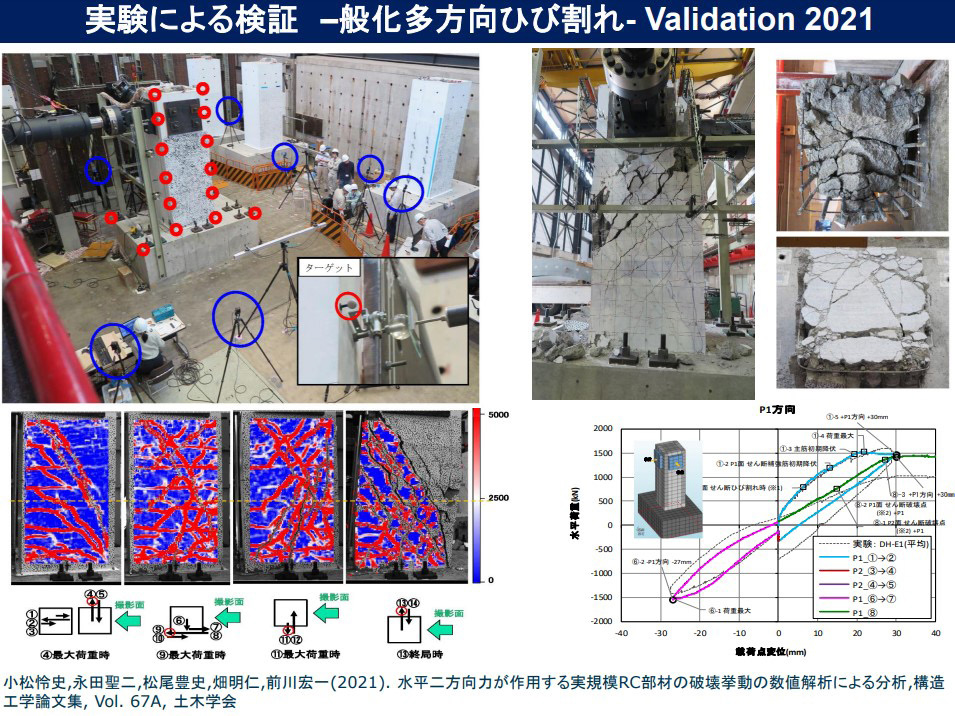
-
 The 8th National Resilience Design Award Award Winning Works
The 8th National Resilience Design Award Award Winning WorksSteady Progress at the Level of Works, with Challenges in New Fields
In the second half of the afternoon session of Day3, announcement of the awards of the 9th National Resilience Design Awards (NaRDA) and the award ceremony was conducted. Targeting the fields of structural analysis, ground and water engineering, and disaster prevention, NaRDA honors initiatives that contribute to national resilience. This time, 11 works were nominated on October 25 from among the entries submitted by October 17. Then On November 15, the awards were decided at the Award-Winning Selection (held at FORUM8 Tokyo Head Office), which consisted of three judges: Jury Chair Hiromichi Yoshikawa, Honorary Professor, Tokyo City University; Masaru Morita, Honorary Professor, Shibaura Institute of Technology, and Akihiko Wakai, Professor, Graduate School of Science and Technology, Gunma University.
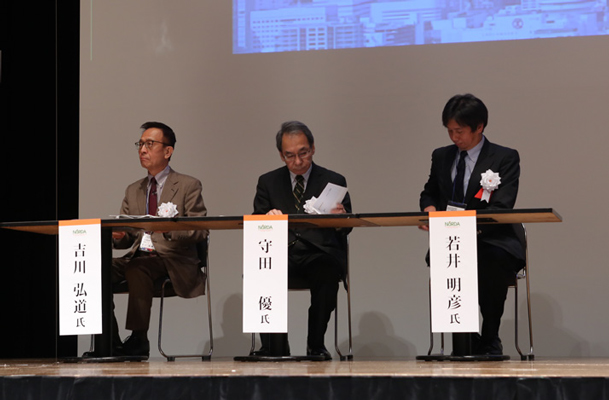
Juries (from the left): Prof. Hiromichi Yoshikawa, Prof. Masaru Morita, Prof. Akihiko Wakai
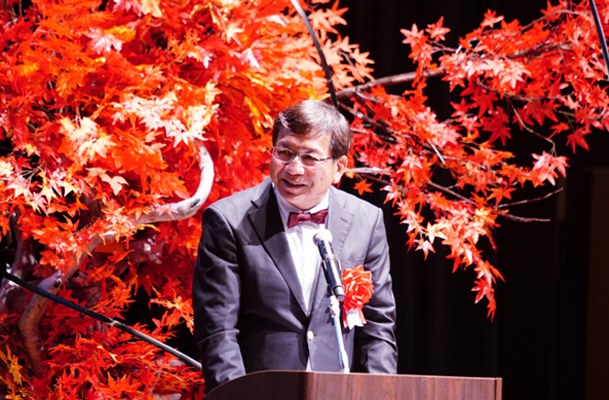
MC Mr. Ryota Ieiri
As a result, the Grand Prix was awarded to "Level 2 Earthquake Dynamic Nonlinear Analysis of Existing Overpass with Composite Piers - Verify a bridge constructed in the early Showa period under the latest seismic loads" submitted by KRAY Inc. This verifies the seismic performance of the 4-span continuous steel plate girder overpass constructed 80 years ago with its sub- and superstructures of the piers as a composite structure. It is modeled for verification by setting the superstructure and steel truss legs as elastic beam elements, and the RC substructure as nonlinear beam elements (M-φ elements) and installing plastic hinge springs at the base of the column. It was highly evaluated that an orthodox object is represented in an easy-to-understand and compact manner, even though the piers partially contain lattice structures and that there is no data on the structure and materials (commented by Prof. Yoshikawa).
The Excellence Award was given to "Preliminary Study of Thermal Cracking Before Construction of New Bridge Abutments – Analysis and countermeasure based on the crack control guideline for mass concrete" by Hagiwara Giken Co., Ltd. In constructing bridge abutments of a simple girder bridge, it assumes crack development due to temperature stress during concrete placement. Analysis of the temperature stress of mass concrete was conducted with JCMAC3 for the construction plan, and simulations were also conducted in which the curing period and driving temperature were changed. It was reviewed (by Prof. Morita) that the overall analysis is detailed, and that it demonstrates the effectiveness of the software in temperature crack analysis in that, for example, it clearly indicates the calculation conditions.
Honorable Judge Award Structural Performance Evaluation Award (Prof. Yoshikawa) was awarded to "Re-analysis of Existing Water Distribution Basins and Verification of Reinforced Seismic Performance – Reinforcement plan to take measures against NG for normal case while keeping water distribution functionality" by Chikyu Giken Consultant. Honorable Judge Award Water Supply Resilience Award (Prof. Morita) went to “Liquefaction Analysis of Water Pipes – Ground deformation due to liquefaction and impact on pipelines” by Wakasuzu Consultants Co., Ltd. Honorable Judge Award Multi-stage Process Analysis Award (Prof. Wakai) was awarded to “Impact Study of Propulsion Pipe Shaft Neighboring Work – Impact analysis of shaft construction near railroad tracks” by SK Engineering Co., Ltd. After each judge announced and awarded the awards, Jury Chair Yoshikawa summarized. He said that the level of entries had been increasing year by year, and this time they had a hard time grading them and decided each award by a narrow margin. He also mentioned that a work on mass concrete was applied for the first time, of which scope is wide-ranging, and therefore further efforts in new fields would be welcomed as well. At the same time, suggesting the importance of representing the main points in a compact, easy-to-understand, and parametric manner, he hoped for more engineers to apply for the next NaRDA.
(Translation up to this part is written by Takashi Ikeno)
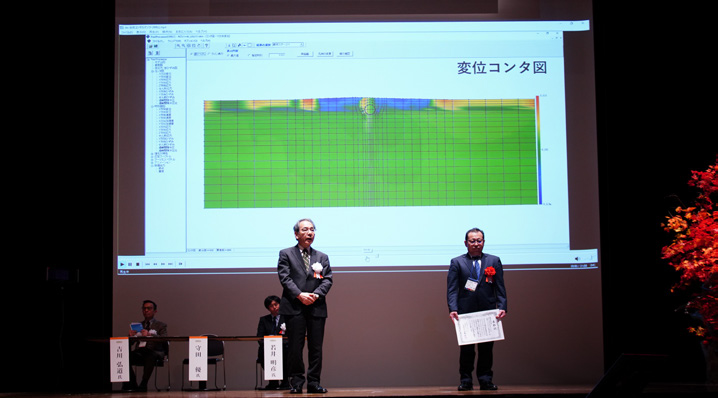
Comments from the juries
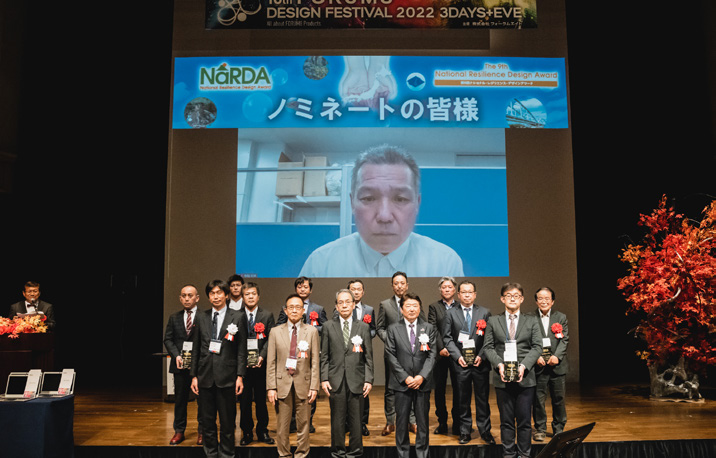
Award winners
Presentation 1
"VR CG software, F8VPS, and Suite ERP which support digital garden city concept"FORUM8 Executive Officer, System Sales Manager
Katsumi MatsudaFinally, FORUM8 gave a presentation following the NaRDA awards ceremony. In "VR CG software, F8VPS, and Suite ERP which support digital garden city concept", a demonstration of real-time simulation using Shibuya data in UC-win/Road explained the functions of importing CityGML, creating road alignment/intersection, driving, and generating traffic flow. He also introduced the possibility of using the simulation as an experimental environment for mobility systems by studying traffic congestion and connecting it to external systems. In addition, as an approach to the realization of the Digital Garden City concept, he introduced seven related case studies. As the latest application examples, he introduced the Utsunomiya City U Smart Promotion Council's "Initiatives for Realization of Smart City" and the Maebashi Living Tech Promotion Project "Digital Twin Safe Driving Scoring" service. UC-win/Road's related functions such as 4D simulation function, IFC file format support, PLATEAU data support, etc. were explained.
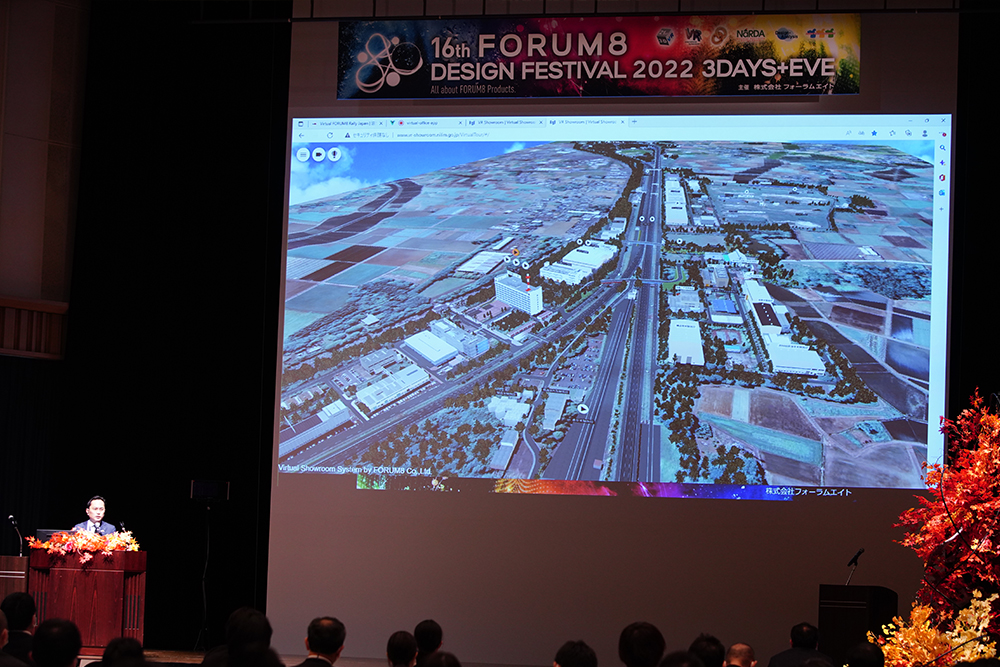
Presentation 2
"Latest features of UC-1 Cloud Auto Design Series and UC-1 BIM/CIM Tool and FORUM8's initiatives for BIM/CIM"FORUM8 Executive Officer, UC-1 Development Manager
Shiro NakaharaIn the "Latest features of UC-1 Cloud Auto Design Series and UC-1 BIM/CIM Tool and FORUM8's initiatives for BIM/CIM" presentation by a development staff member, product overviews of UC-1 series, interlocking between products, and the lineup and functions of each product in the cloud-based automatic design series were introduced. In addition, as BIM/CIM initiatives, he explained the 3D parametric tool, which enables quick and easy generation of 3D models of structures, and the UC-1 BIM/CIM tool, which enables creation of 3D integrated models, in addition to 3D reinforcement, 3D annotation and attribution, and IFC file export functions. As for the future development of the UC-1 series, he indicated the further expansion of the lineup of products that support 3D CAD and 3D reinforcement and the Cloud Series, as well as the enhancement of maintenance management-related products and design result support systems.
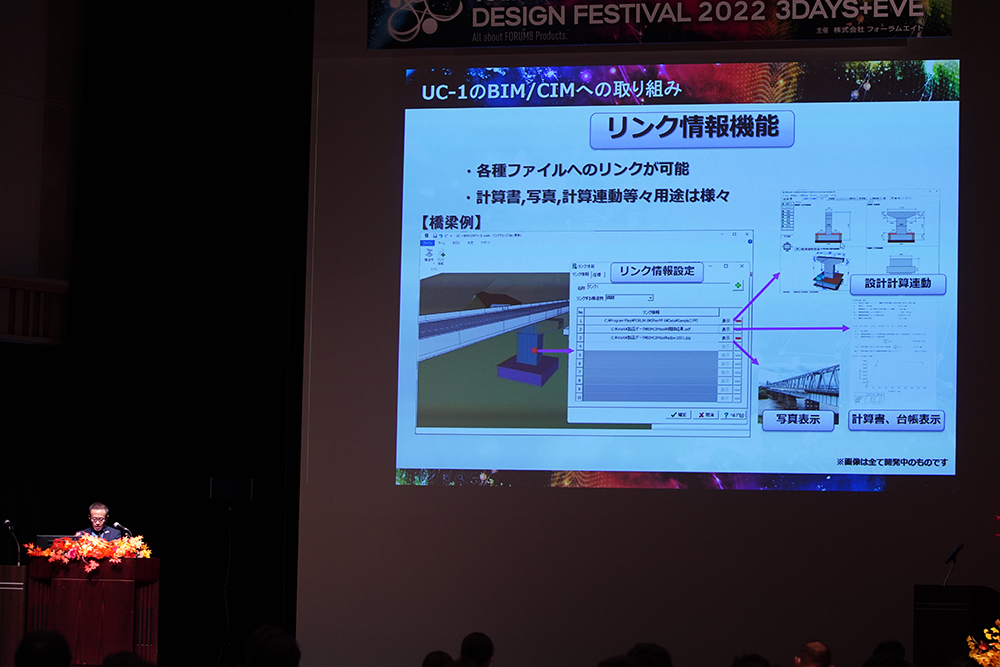
Presentation 3
"Newest information on FEM analysis solutions and structural and geotechnical analysis programs"Group leader of FORUM8 Analysis support Group
Masakichi YanagiIn the "Newest information on FEM analysis solutions and structural and geotechnical analysis programs", the latest product functions, development progress, and analysis case studies were introduced for FEM analysis solutions, including the correspondence to the latest Guidelines for Earthquake-Resistant Construction Methods for Waterworks Facilities 2022. In addition, a demonstration was given of the plane element remesh function as a new feature of Engineer's Studio®Ver.11, which is currently under development. He also introduced plans for GeoEngineer's Studio to support consolidation coupled analysis in Ver. 3, which is currently under development, including the addition of a modified Cam Clay model and the Sekiguchi-Ohta model constitutive law.
(Translation up to this part is written by FORUM8)
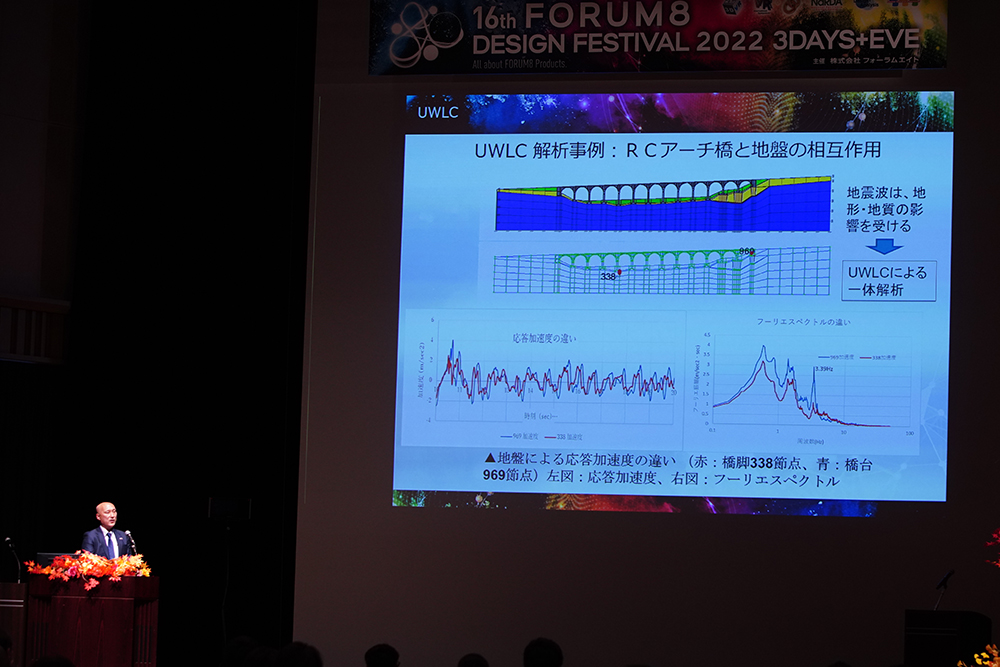
-
Published Literature Presentation
First Official Guidebook for Engineer's Studio's® Written by Analysis Support Professionals
DF Day 3 concluded with a lecture on a new publication. Every year, FORUM8 Publishing publishes new publications at the time of DF. During the DF period, a section is set up to focus on the new publications, where the authors introduce them by themselves.
The target book of this time is “Engineer’s Studio® Guidebook". The author of the book, a person in charge of FORUM8 Analysis Support Group gave a lecture. First of all, he explained the analysis support work that the group is in charge of and the positioning of the use of Engineer's Studio® there. Then he mentioned the intention of the authors with such a background to aim at creating the contents that are easy for beginners to understand and useful for practical work and systematizing them so that they can meet the needs of intermediate and advanced users while improving their skills.
As one of the features of this book, the screen for creation (model setting) that appears when the user starts Engineer's Studio® is inserted at the beginning of the book across facing pages. The contents are largely composed of 5 chapters. Chapter 1 explains the basic operation procedure from system settings to the interface. Chapter 2 shows how to create various models for each purpose with actual examples. Chapter 3 explains the procedures for acquiring and confirming the results of analysis and verification, as well as the basic operations for outputting reports, and Chapter 4 illustrates applied techniques and advanced analysis functions using examples of horizontal load-bearing capacity verification during earthquakes and damage assessment of flat plate elements. Chapter 5 describes models such as 14 bridges, 4 river structures, and 4 other models with the aim of covering as many analysis cases as possible in the past as use cases.
He also mentioned the ingenious points thought up for the first official guidebook of Engineer's Studio's®. For example, many tips with information on frequently used functions and techniques are incorporated through each chapter.
(Translation up to this part is written by Takashi Ikeno)

■ Contents
Chap.1 Basic operations & Interface
Chap.2 Create models for different purposes
Chap.3 Check results and create reports
Chap.4 Technique and advanced functions
Chap.5 Use cases■ Author: FORUM8 Analysis Support Group
■ Date of issue: November 2022
■ Price: 2,700 yen
■ Publisher: FORUM8 PublishingVisit FORUM8 official website, amazon.co.jp, rakuten.co.jp, or yahoo.co.jp to purchase the book.



